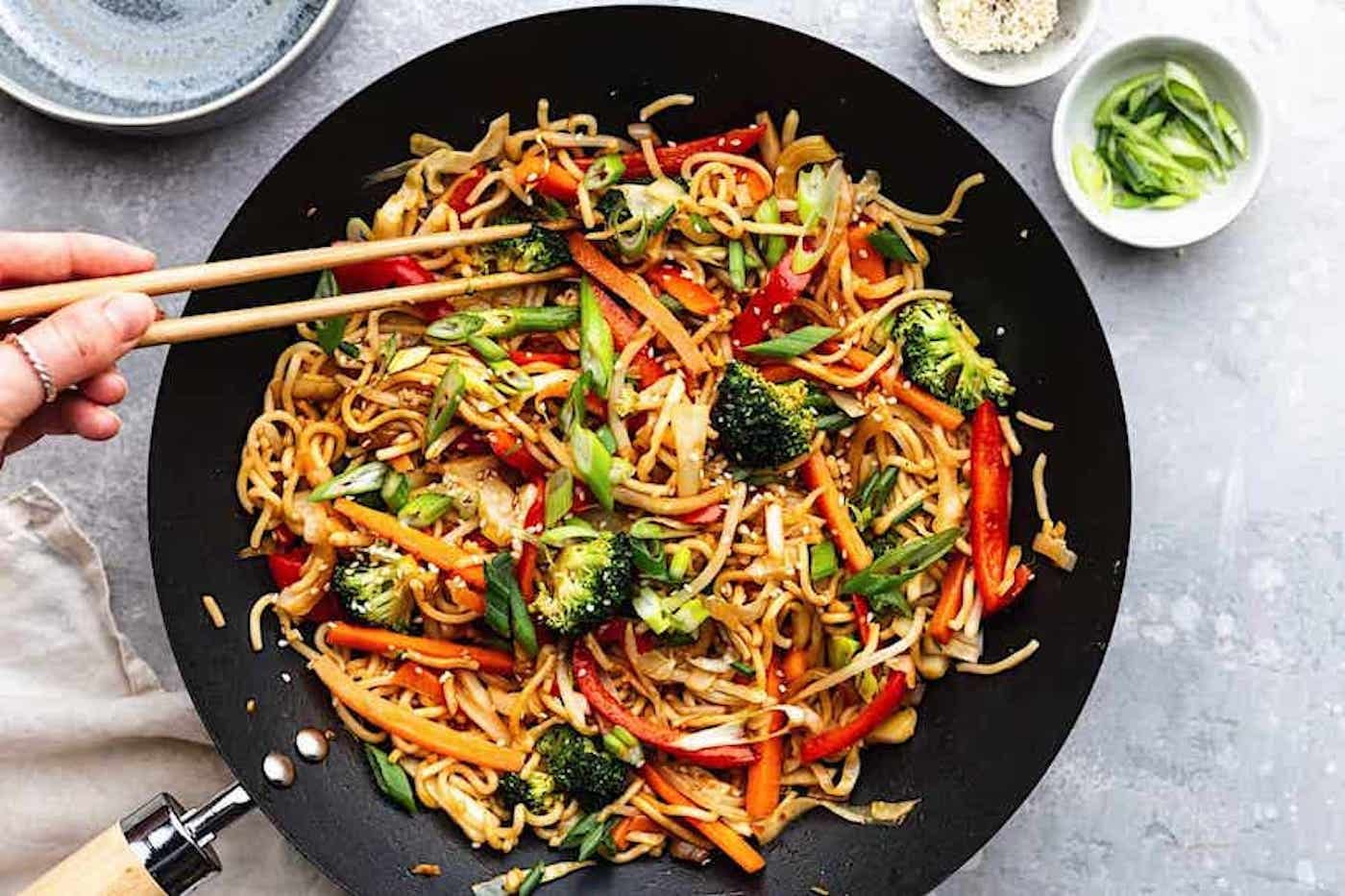Take Me to the Recipes
While Chinese cuisine is celebrated worldwide for its diverse range of dishes, it is the artful fusion of ingredients and centuries-old culinary techniques that truly define this culinary landscape. In recent years, as the world grapples with sustainable and ethical dietary choices, Chinese Vegan Food has emerged as a vibrant and enticing dimension of the country’s culinary heritage.
China, with its vast geographical expanse and cultural diversity, boasts a kaleidoscope of plant-based delicacies that tantalize the taste buds while reflecting the nation’s deep-rooted connection to nature. From the bustling metropolises of Shanghai and Beijing to the serene landscapes of Guangzhou and Chengdu, vegan cuisine in China not only caters to a growing community of plant-based enthusiasts but also showcases a profound respect for seasonal, local ingredients.
In this exploration of Chinese vegan food, we delve into the myriad textures, flavors, and techniques that form the heart of this culinary tradition. From delectable dim sum to hearty stir-fries, each dish tells a story of innovation and adaptation within the rich tapestry of Chinese gastronomy. Join us on a culinary odyssey that uncovers the essence of Chinese vegan cuisine, where tradition meets contemporary values in a harmonious celebration of plant-based delights.
48 Mouthwatering Chinese Vegan Food Recipes – Click on the image for The Recipe


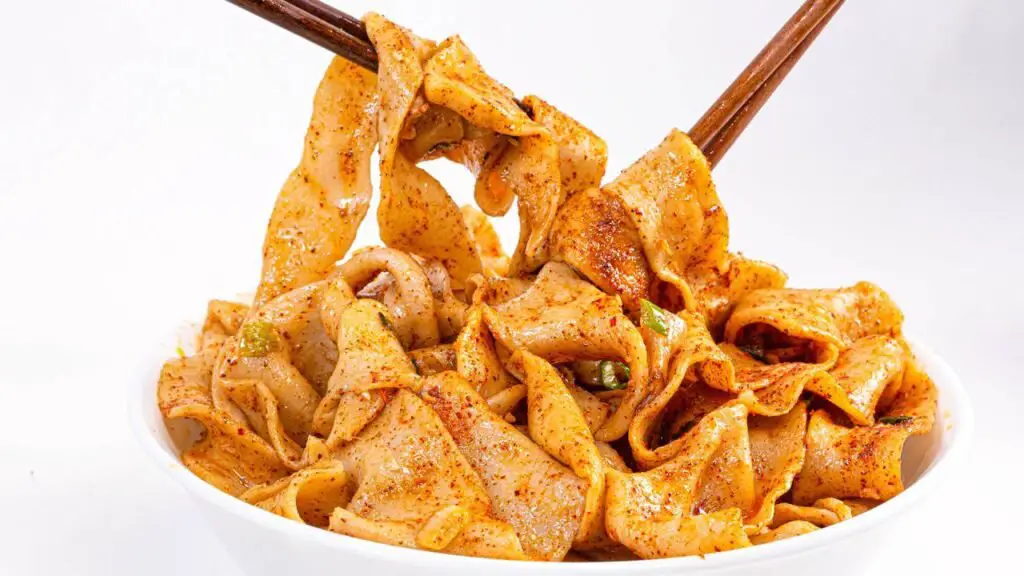
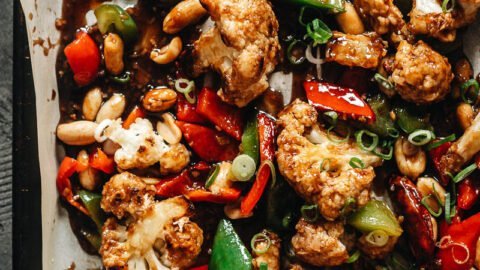
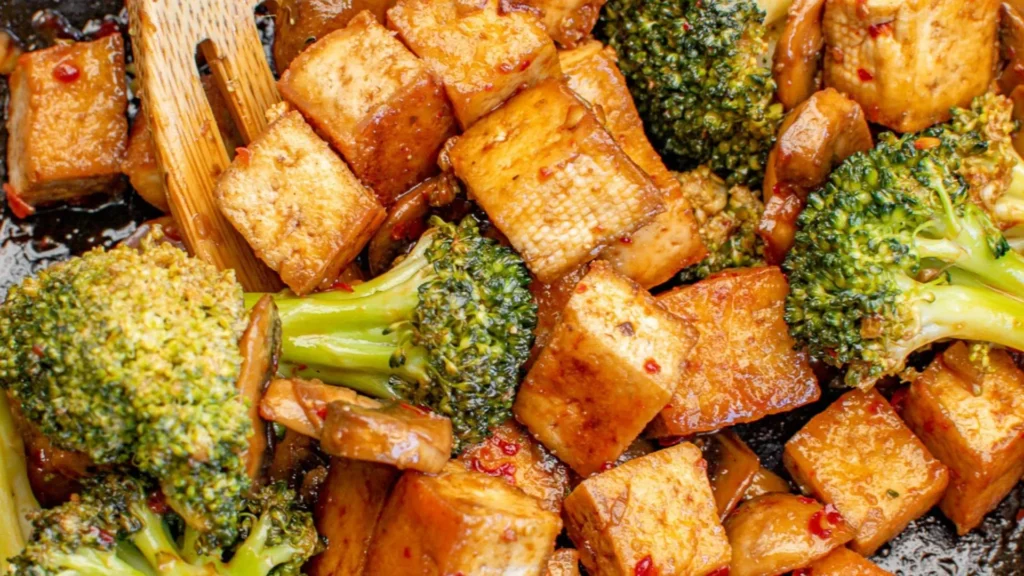
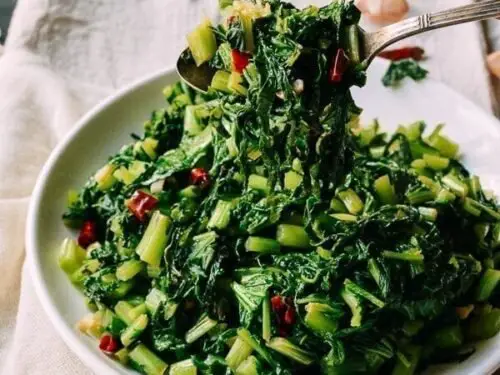
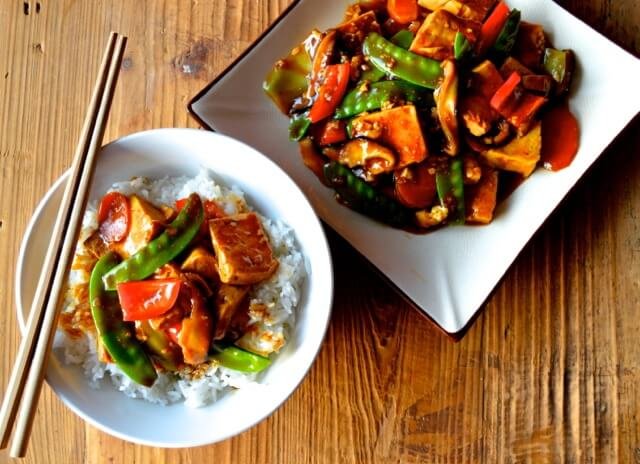
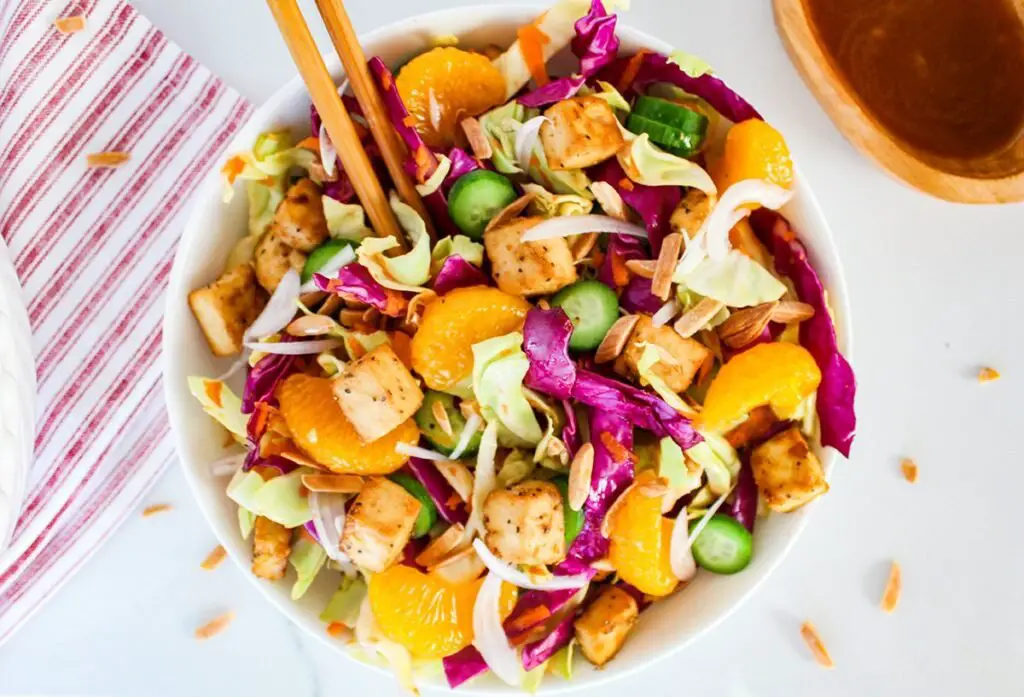
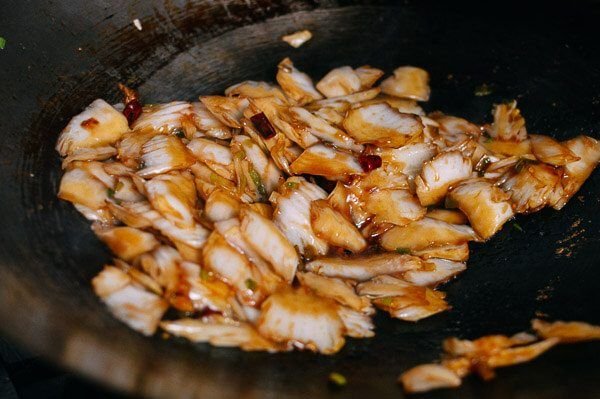
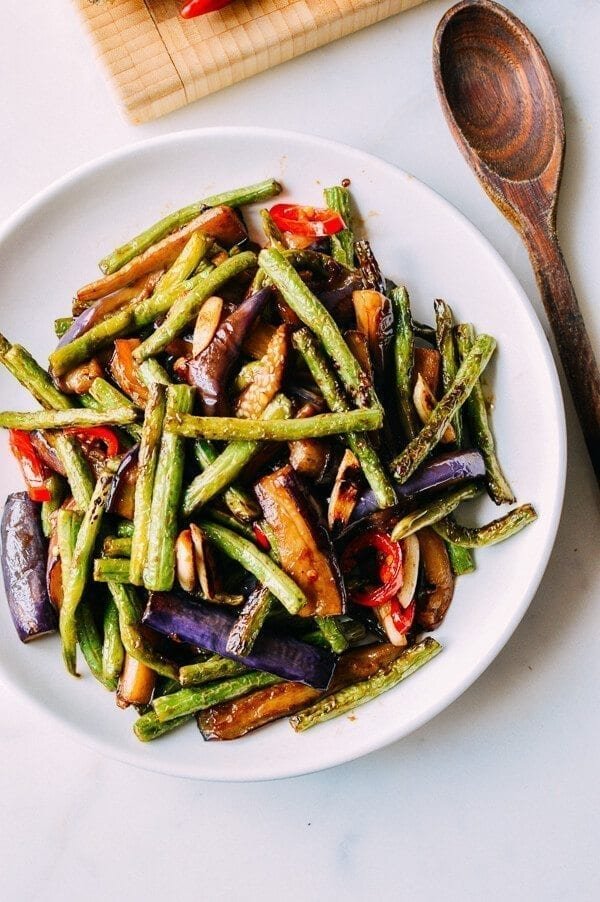
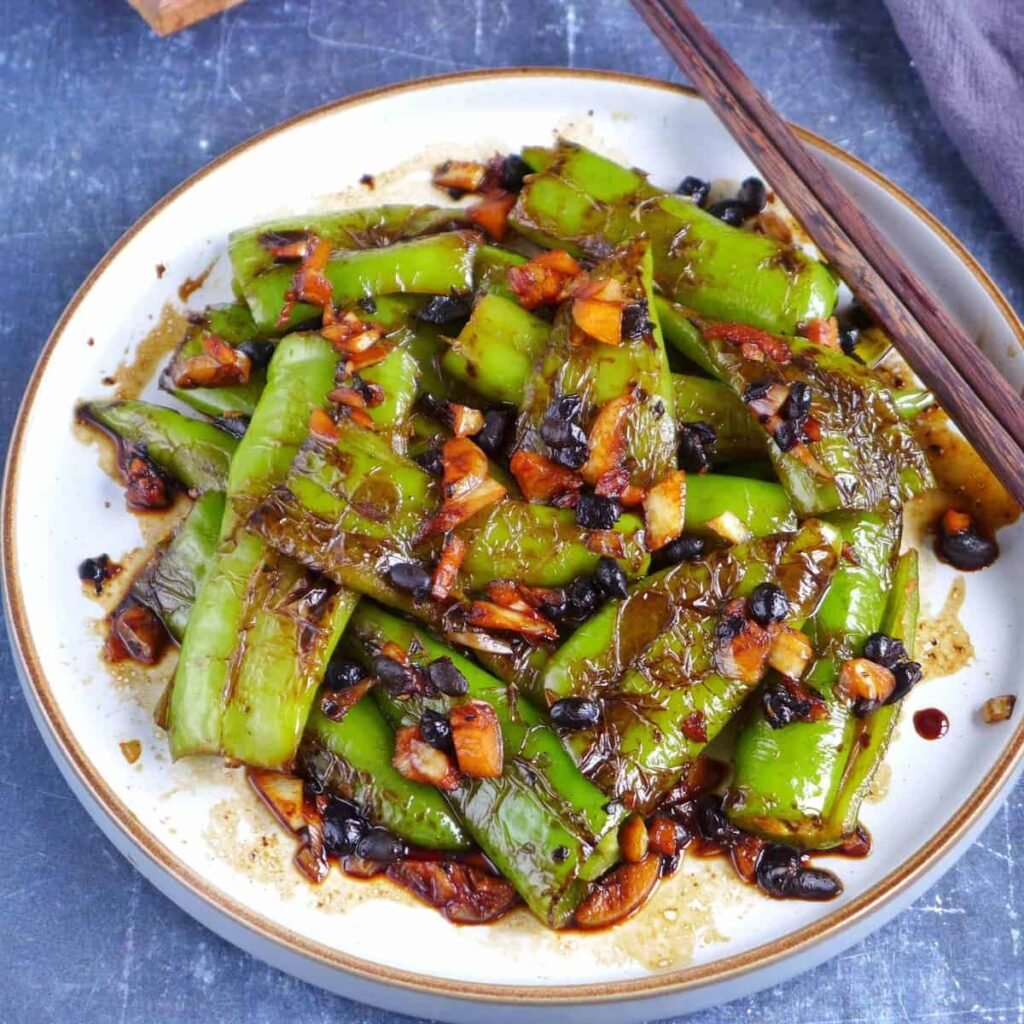
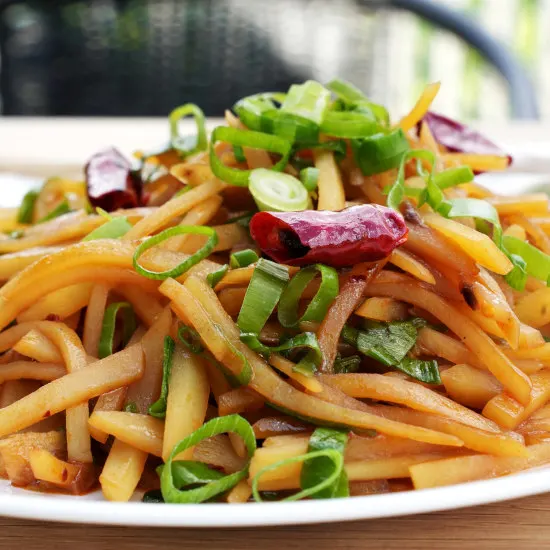
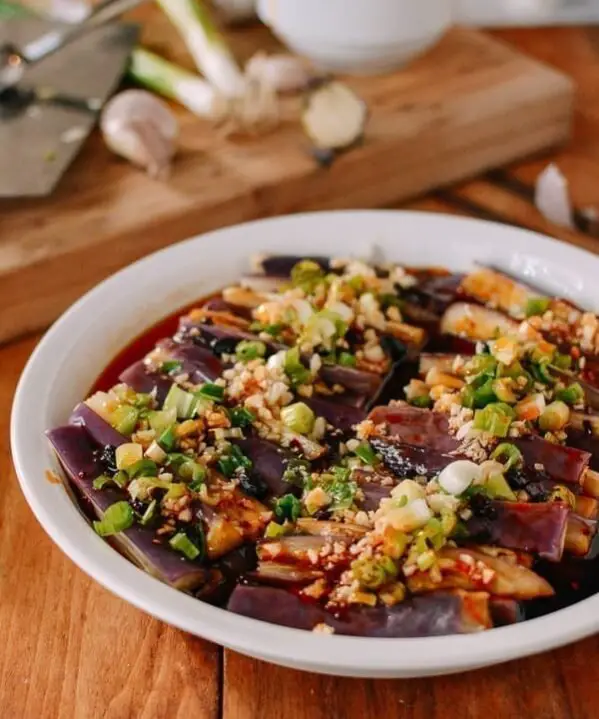
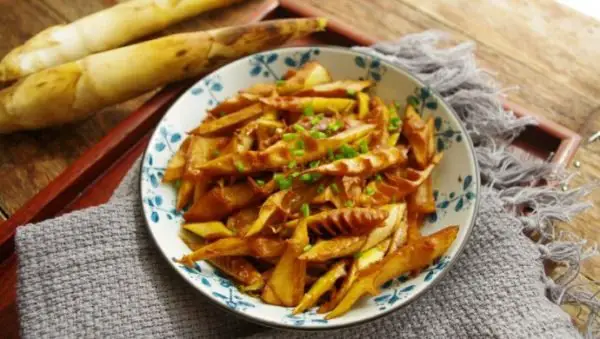
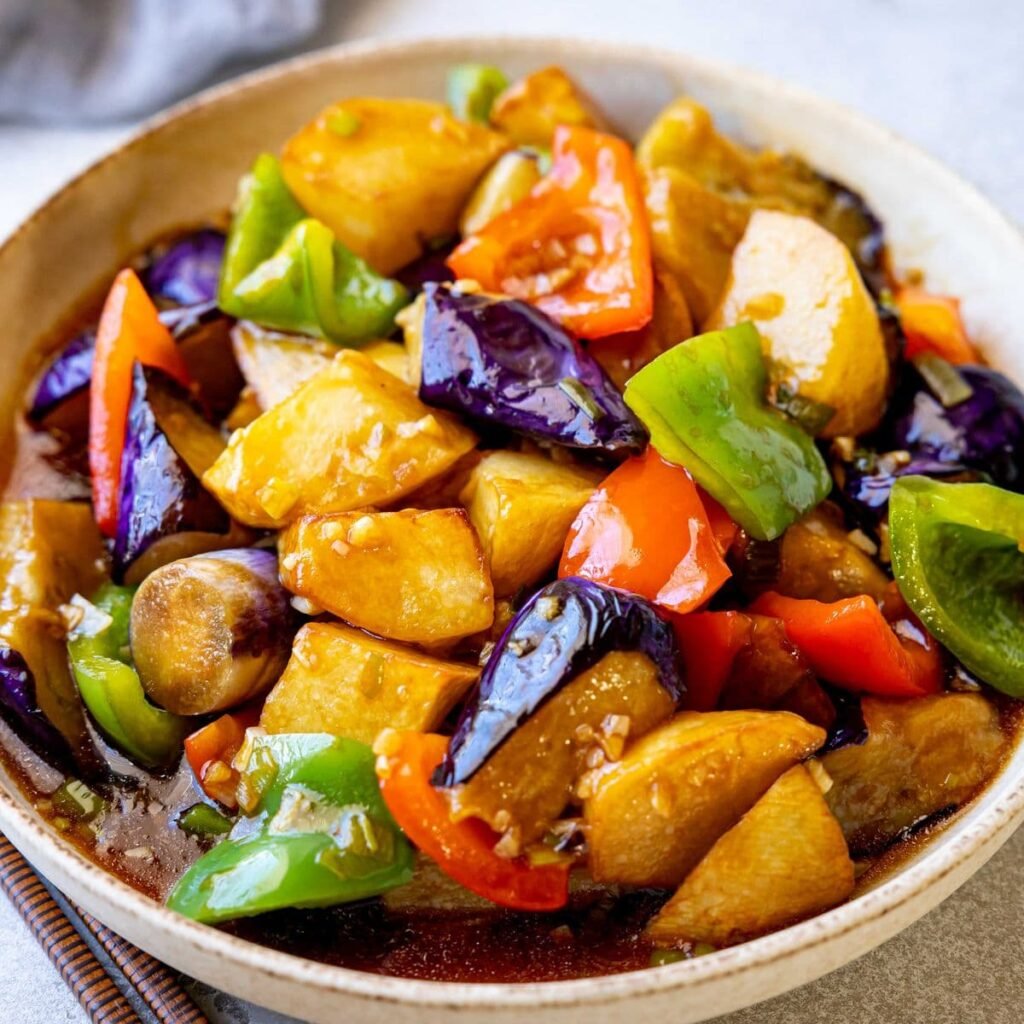
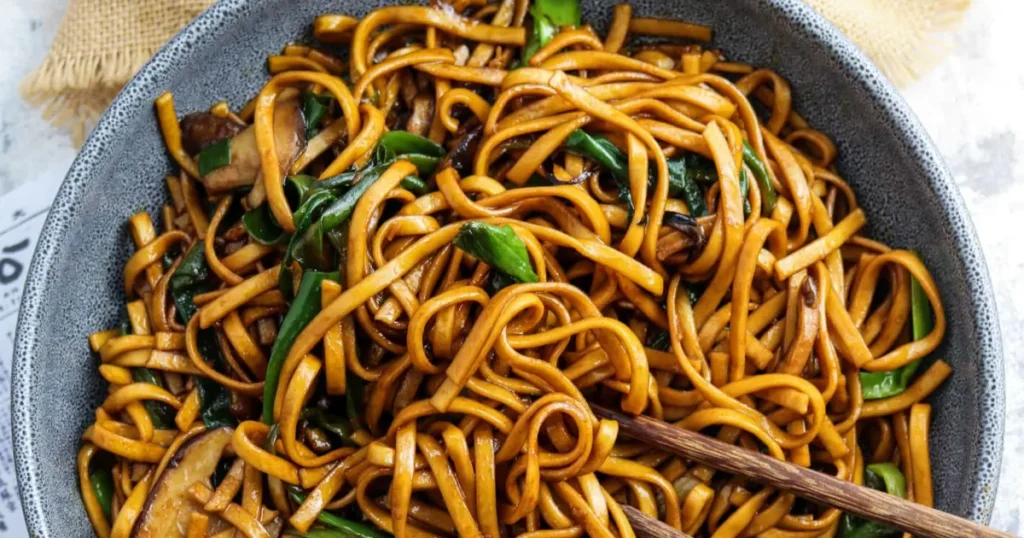
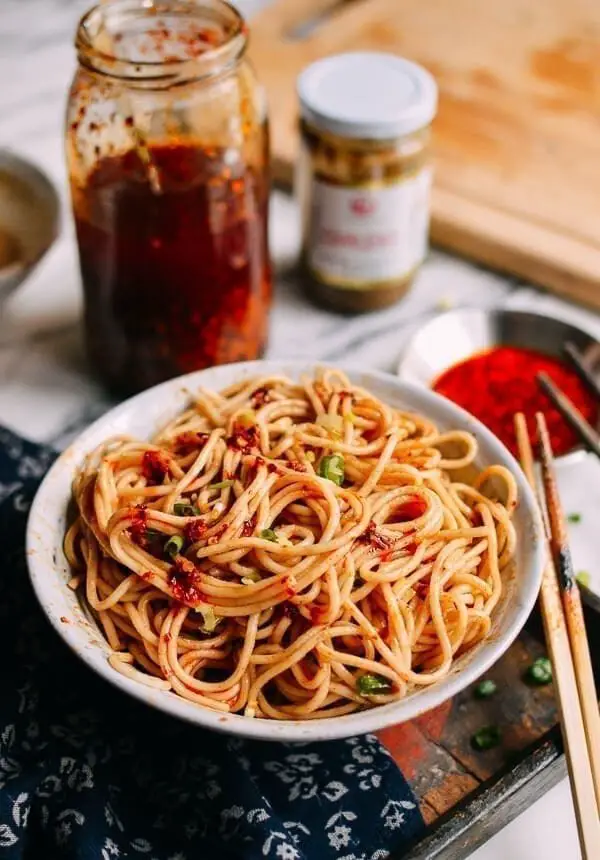
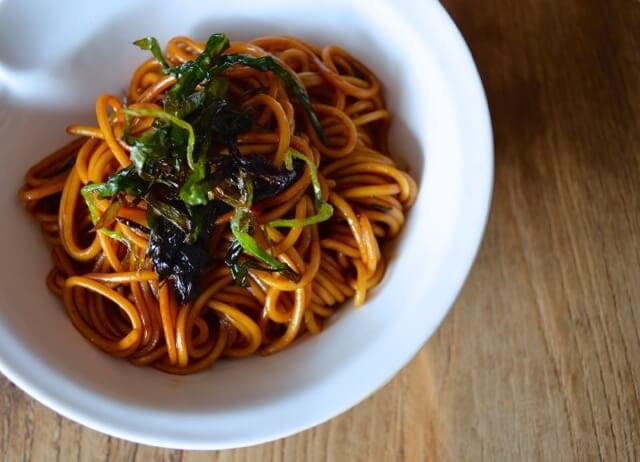
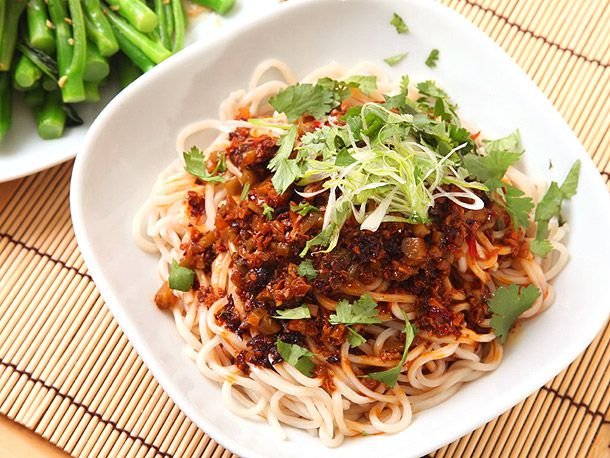
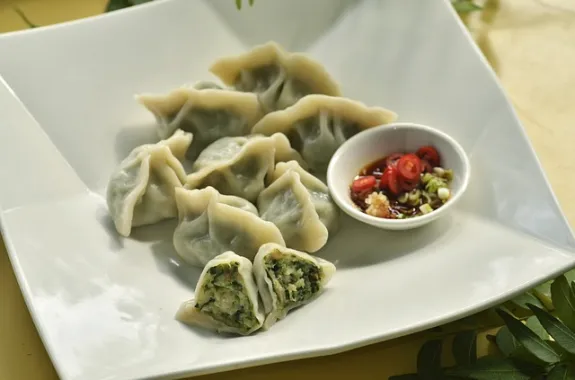
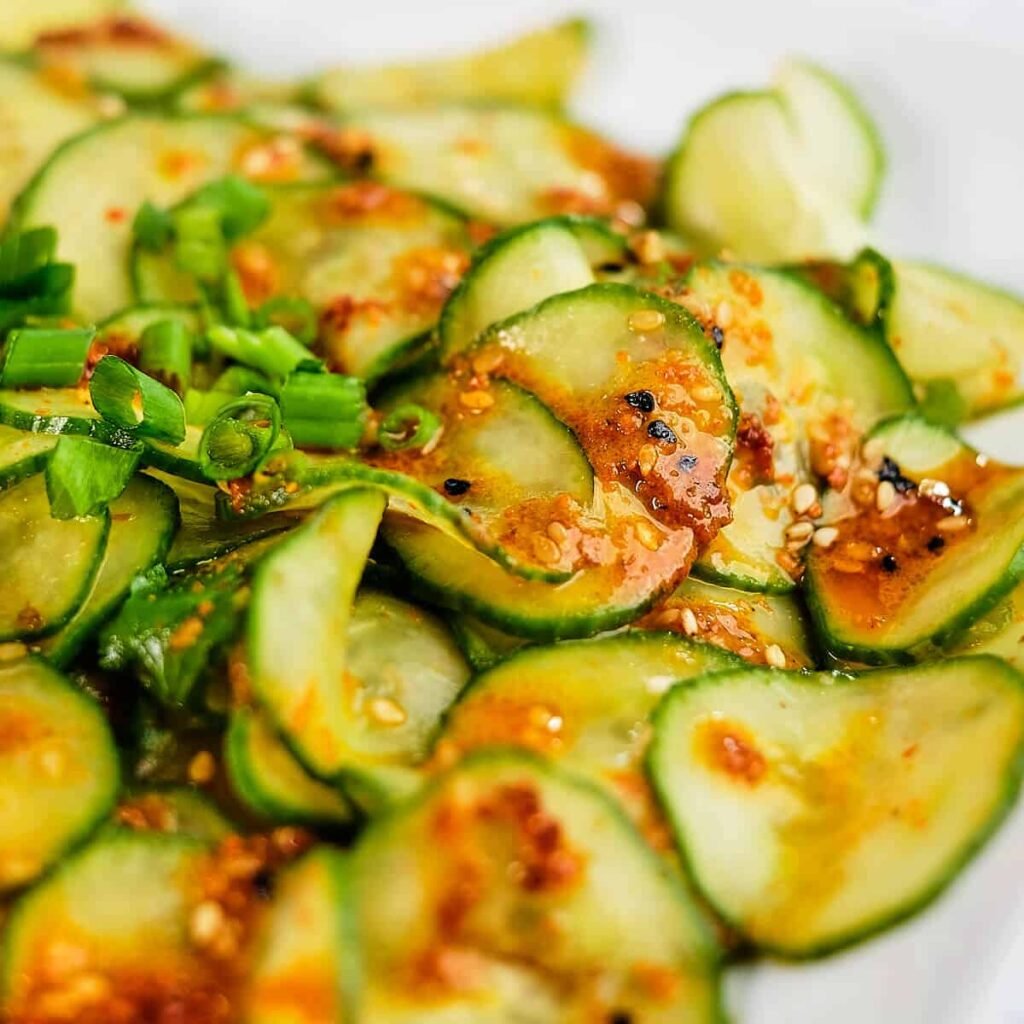
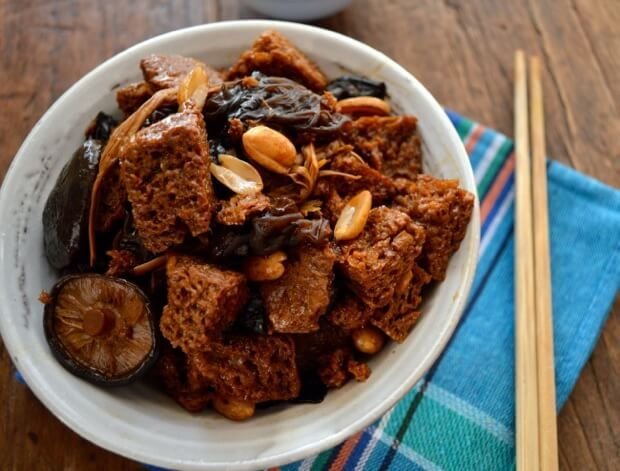
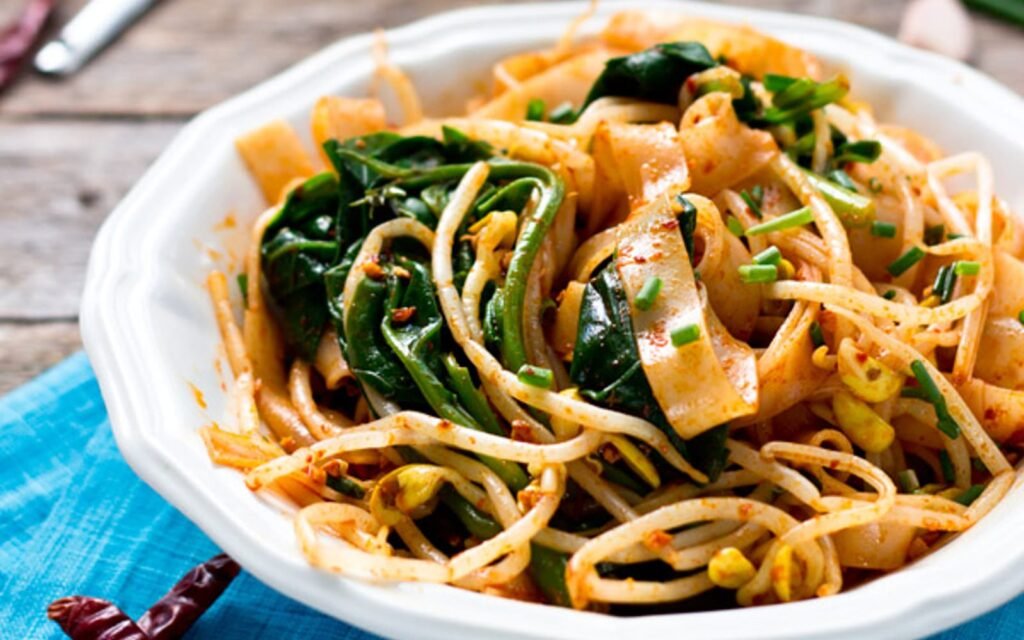

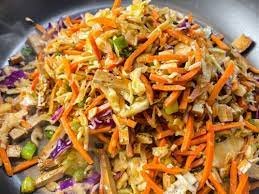
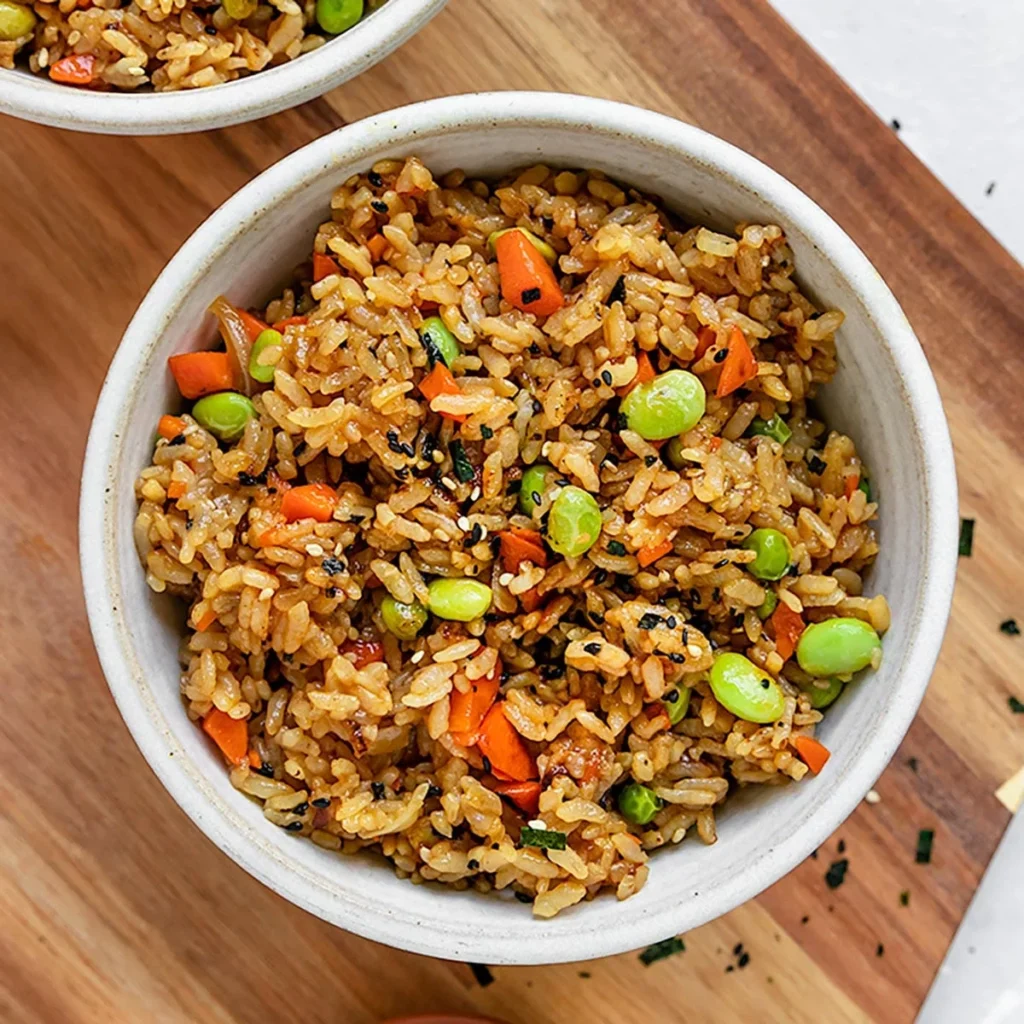
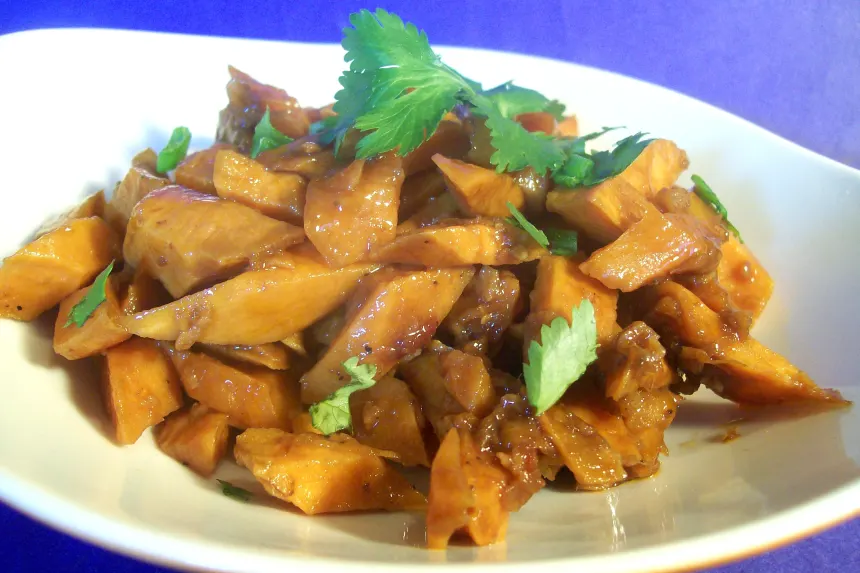
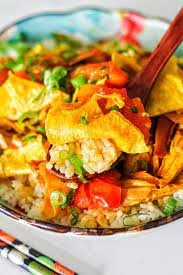
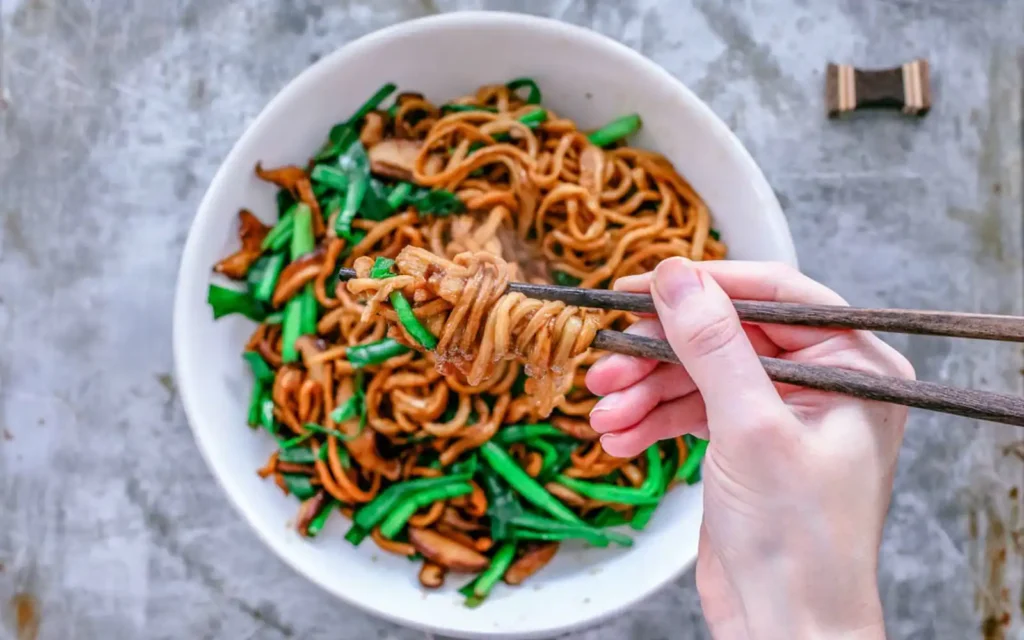
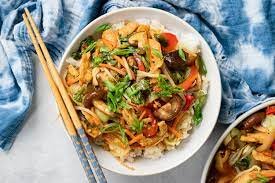
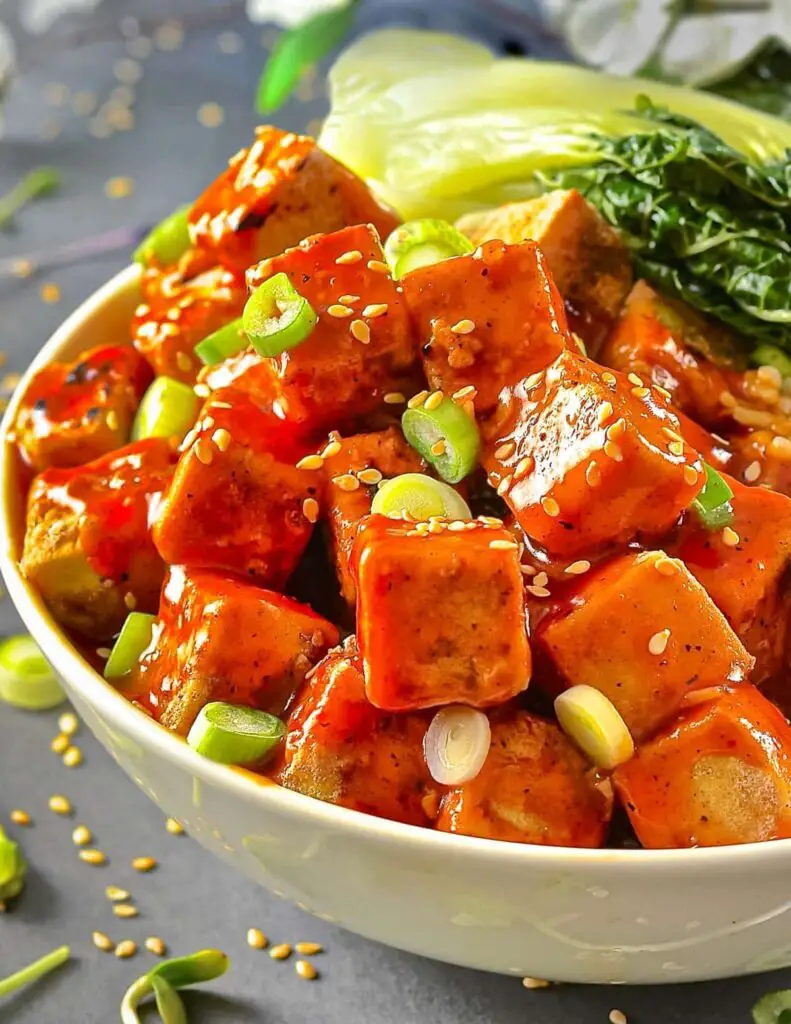

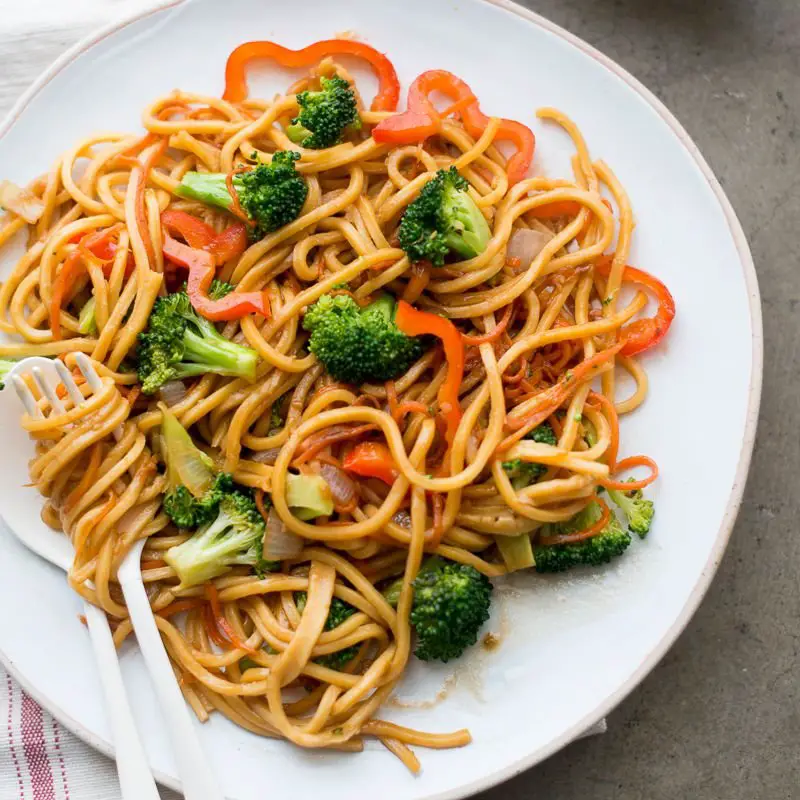

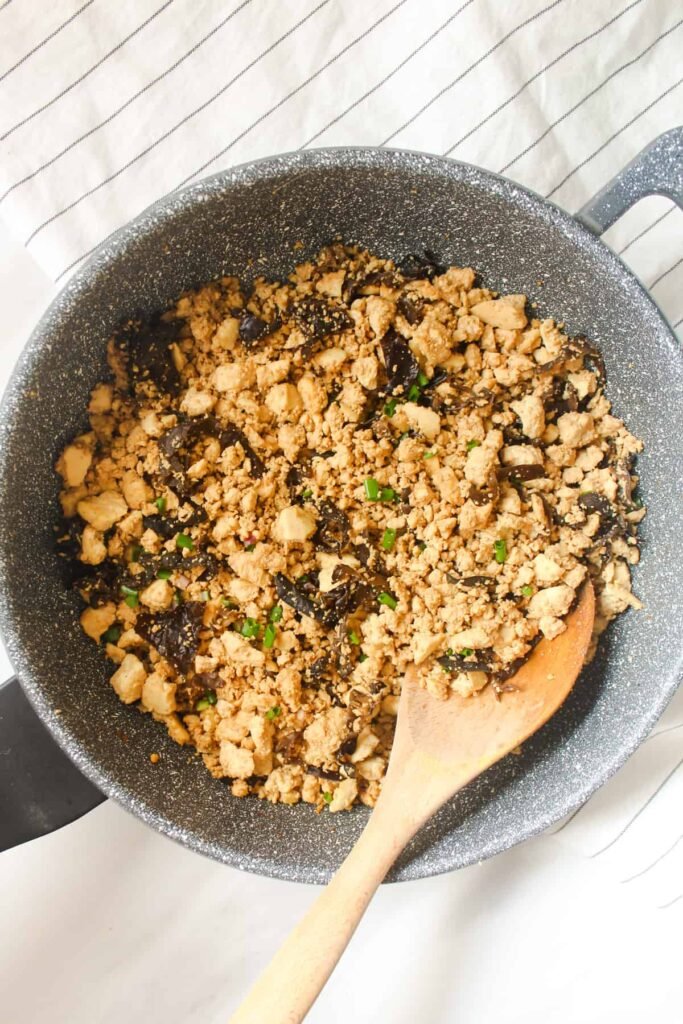
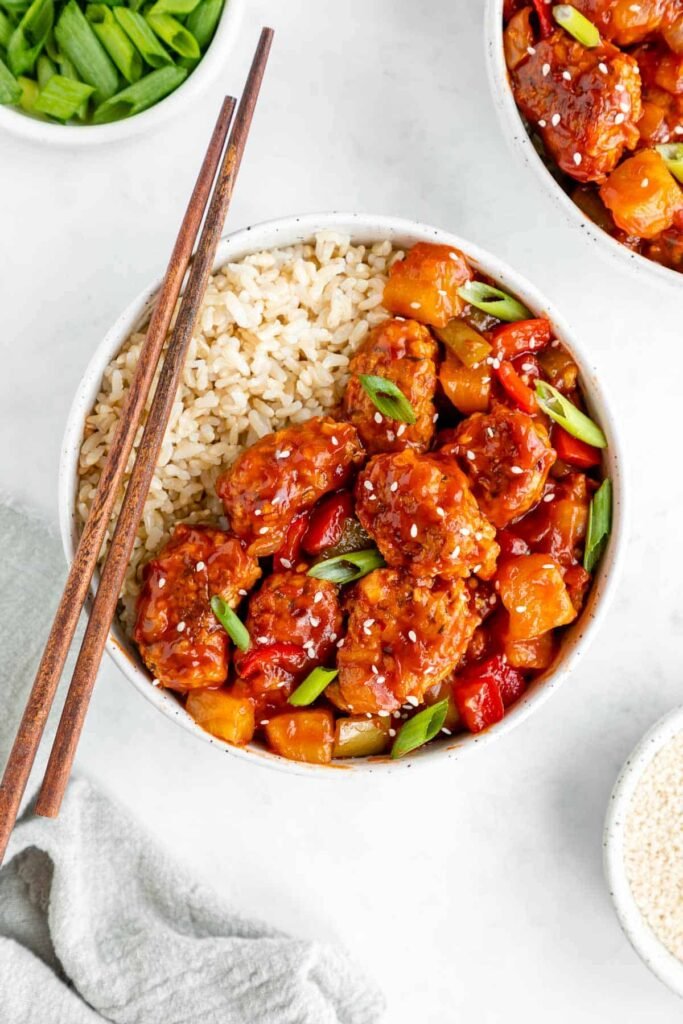
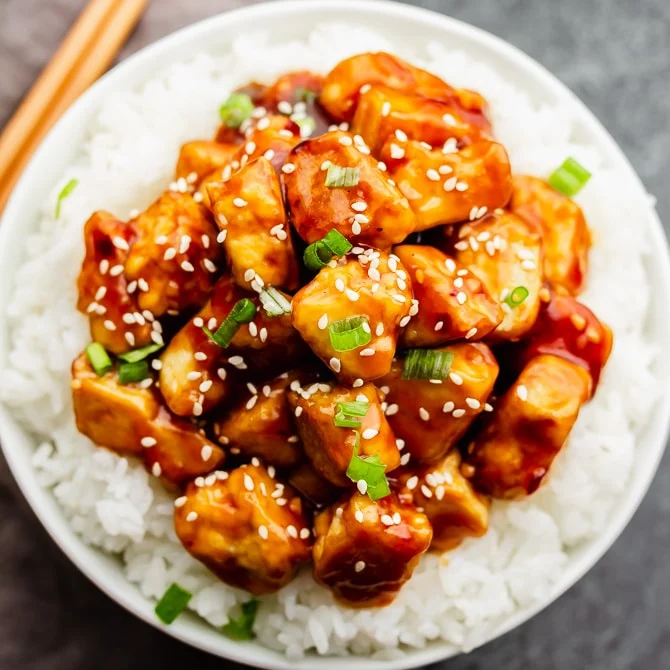
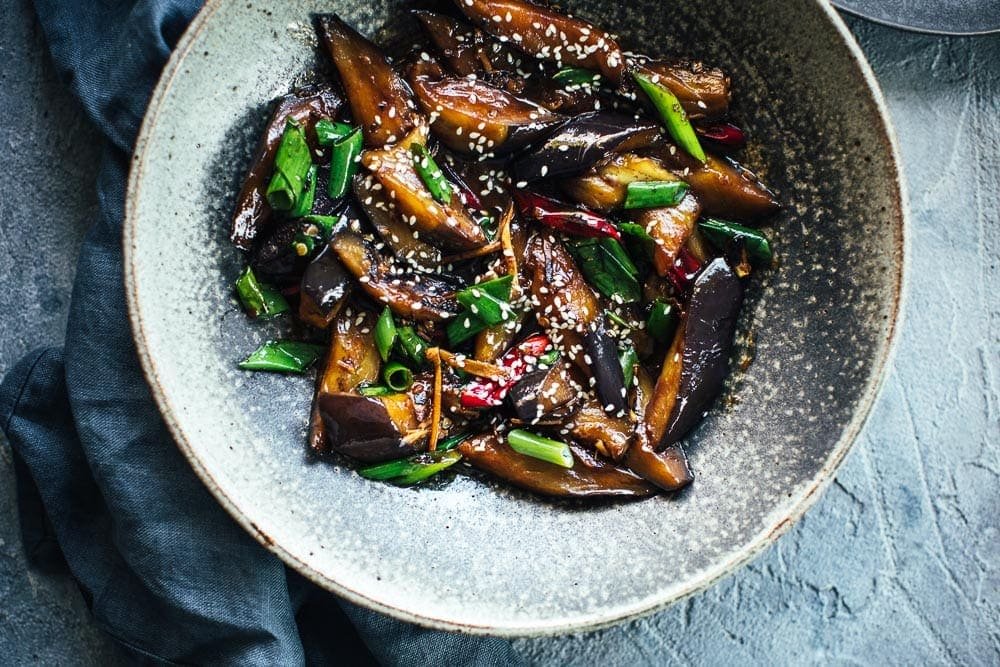
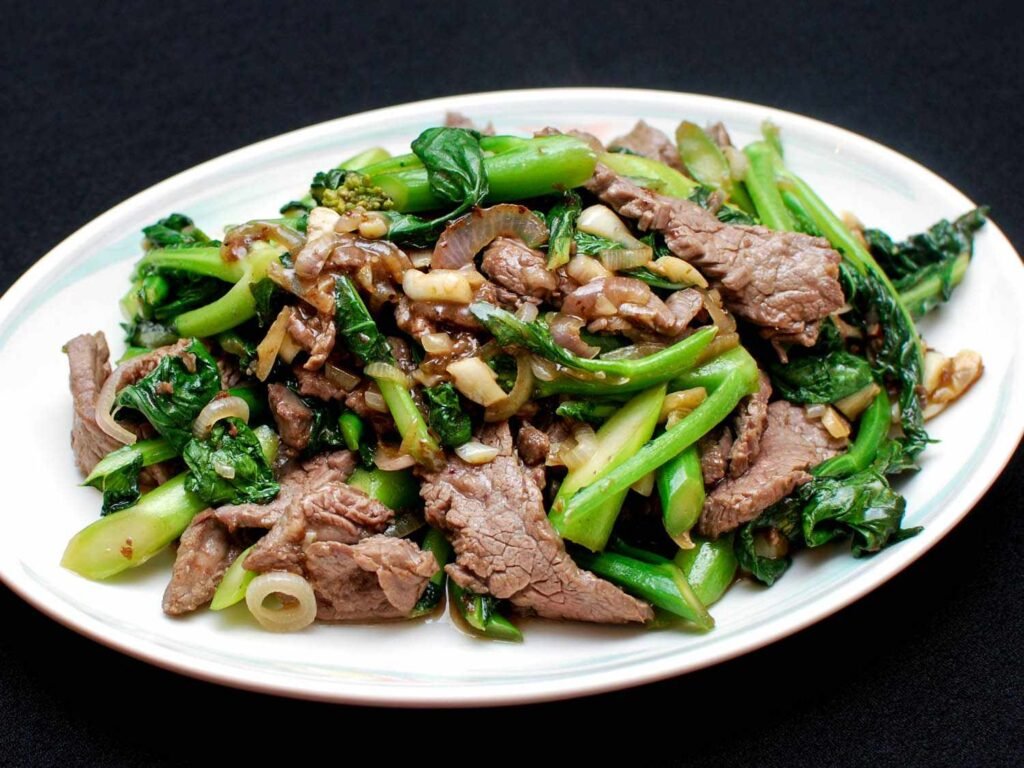
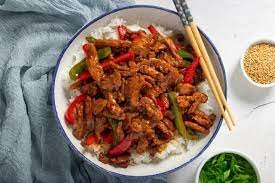
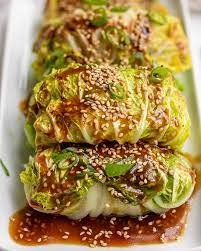
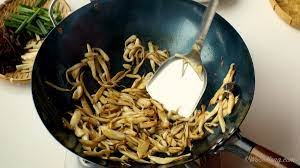
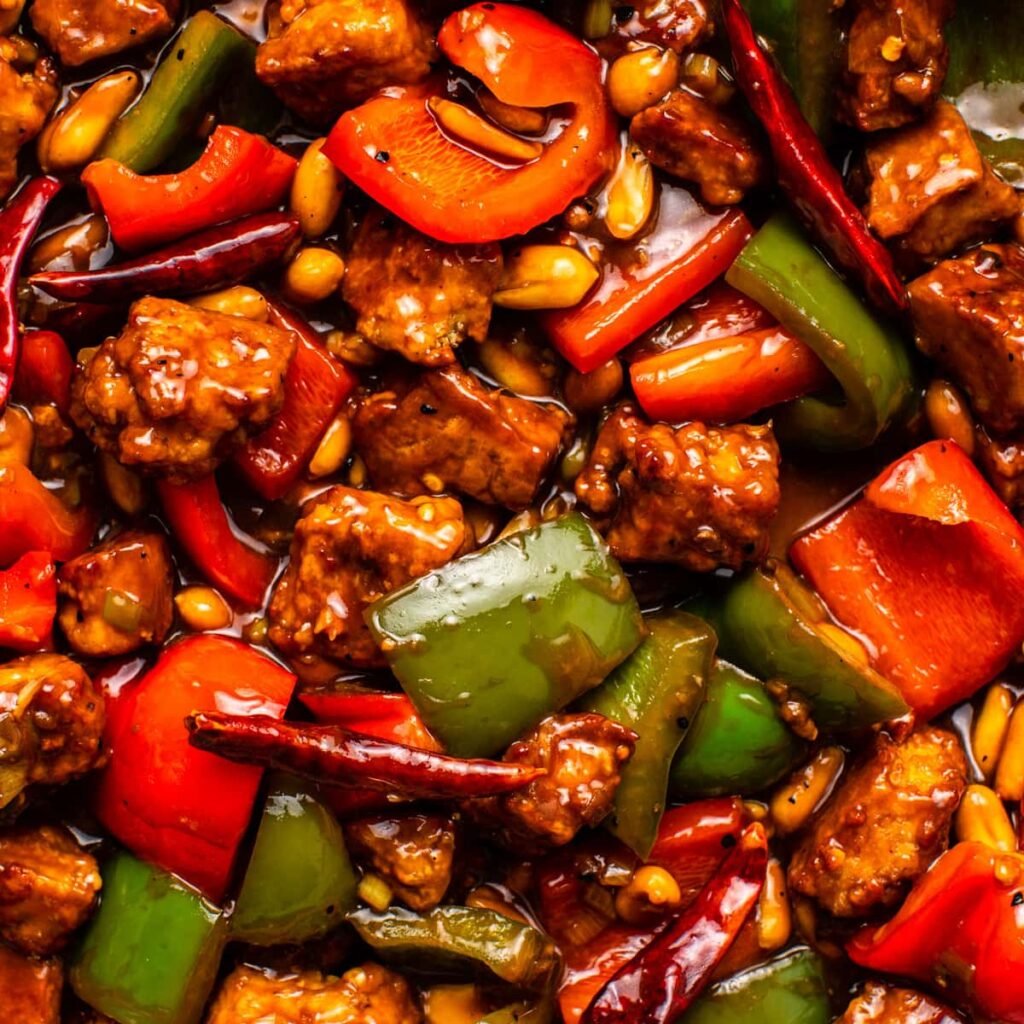
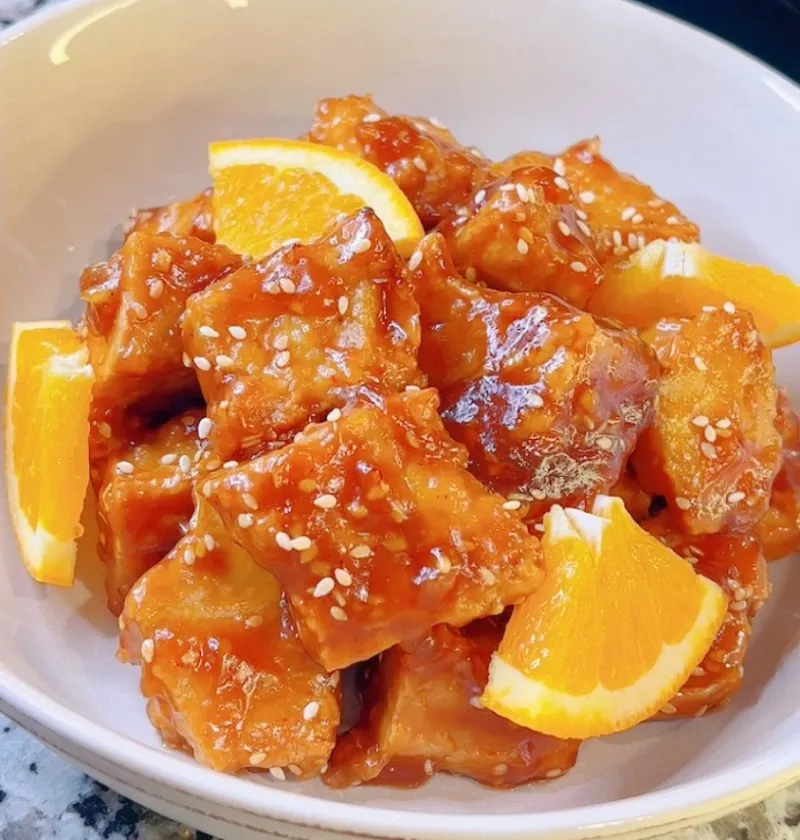
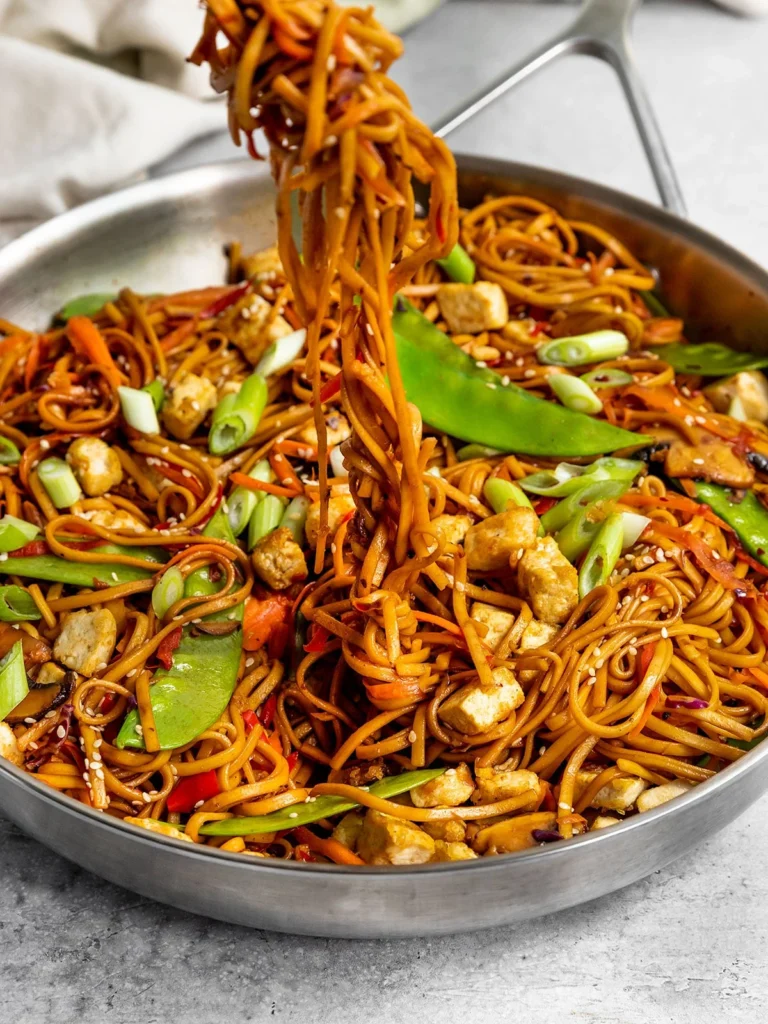
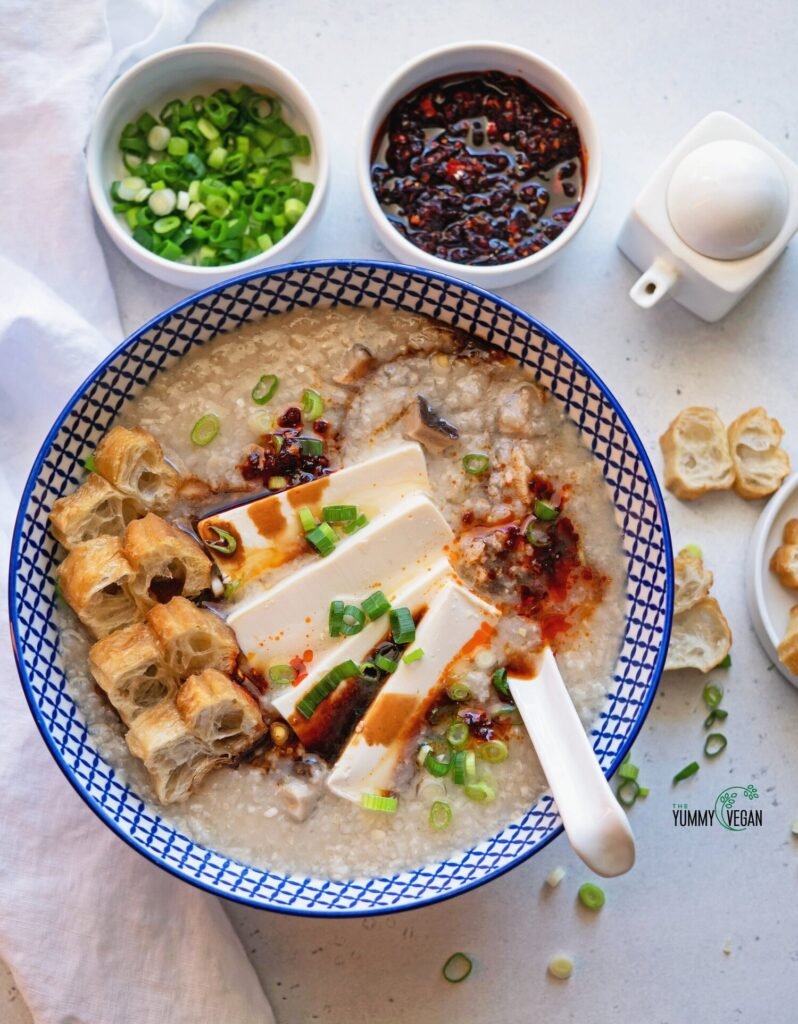
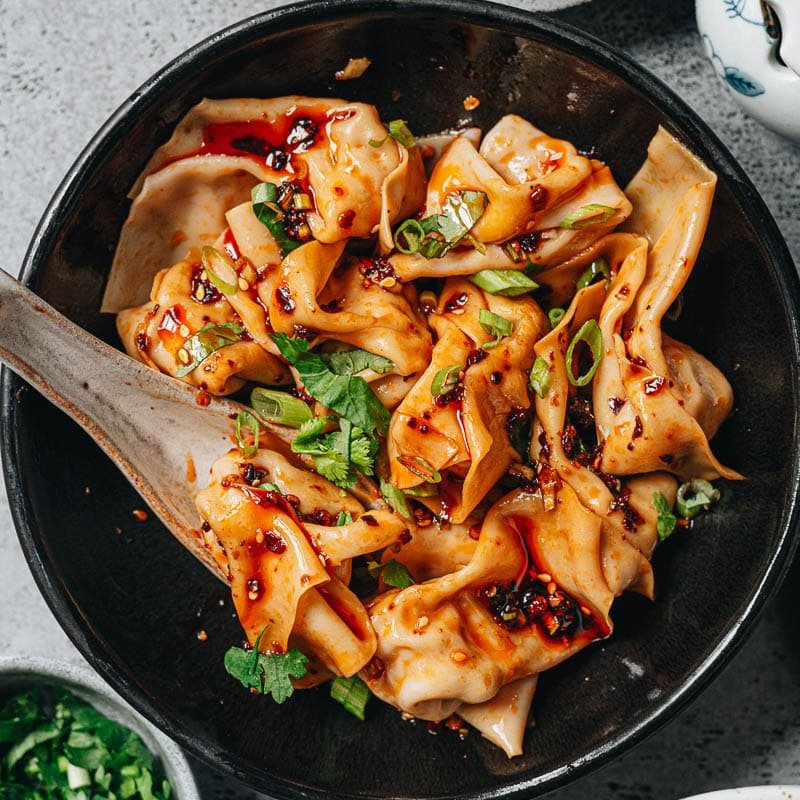
Other Articles you might Enjoy
- Chinese Food – A delightful exploration
- 24 Chinese Beef Recipes
- 48 Mouthwatering Chinese Vegan Food Recipes
- 41 Irresistible Sweet Chinese Desserts
- North and South American Cuisine – A Culinary Expedition
- European Cuisine: Savor the Continent’s Best Culinary Secrets!
- African Cuisine: Discover the Bold Flavors & Global Charm!
- Asian Cuisine Unlock its Secrets – Taste, Health & Global Influence!
- Oceania Cooking: A Culinary Journey Through the Pacific
Chinese Vegan Food – Sichuan Spicy Wontons in Chili Sauce

History and Background
Sichuan Spicy Wontons in Chili Sauce, known as “红油抄手” (Hóng Yóu Chāo Shǒu) in Chinese, originates from the Sichuan province, renowned for its bold and flavorful cuisine. The dish is a popular street food and a classic part of Sichuan cuisine, celebrated for its spicy and numbing flavors derived from Sichuan peppercorns and chili oil. Wontons, traditionally filled with minced pork, are bathed in a fiery chili sauce, creating a harmonious blend of heat and complexity.
Region of Origin
Sichuan, located in the southwestern part of China, is known for its rich culinary traditions. The province is characterized by a humid climate and fertile land, resulting in a diverse range of ingredients. Sichuan cuisine is famed for its use of bold flavors, including the signature “ma la” (numbing and spicy) combination, which is evident in dishes like Spicy Wontons in Chili Sauce.
Chinese Vegan Food – Sichuan Spicy Wontons in Chili Sauce Ingredients:
- Wonton Filling:
- 1 cup finely chopped mushrooms
- 1 cup firm tofu, pressed and crumbled
- 2 tablespoons soy sauce
- 1 tablespoon sesame oil
- 1 tablespoon rice vinegar
- 1 teaspoon Sichuan peppercorns, toasted and ground
- 1 tablespoon ginger, minced
- 2 cloves garlic, minced
- 1 green onion, finely chopped
- Wonton Wrappers:
- 1 pack of square wonton wrappers
- Chili Sauce:
- 3 tablespoons soy sauce
- 2 tablespoons Chinkiang black vinegar
- 2 tablespoons sugar
- 3 tablespoons chili oil
- 1 teaspoon sesame oil
- 2 cloves garlic, minced
- 1 teaspoon Sichuan peppercorns, toasted and ground
Chinese Vegan Food – Sichuan Spicy Wontons in Chili Sauce Recipe:
Wonton Filling:
- In a mixing bowl, combine chopped mushrooms, crumbled tofu, soy sauce, sesame oil, rice vinegar, ground Sichuan peppercorns, minced ginger, minced garlic, and chopped green onion.
- Mix the ingredients thoroughly to ensure an even distribution of flavors.
Wonton Assembly:
- Lay out a wonton wrapper and place a small amount of the filling in the center.
- Moisten the edges of the wrapper with water and fold it into a triangle, ensuring all edges are sealed tightly.
- Bring the two opposite corners of the triangle together and press to seal, forming a classic wonton shape.
- Repeat until all wrappers are filled.
Chili Sauce:
- In a separate bowl, mix soy sauce, black vinegar, sugar, chili oil, sesame oil, minced garlic, and ground Sichuan peppercorns.
- Adjust the sauce to your preferred level of spiciness and sweetness.
Cooking:
- Bring a pot of water to a boil and cook the wontons until they float to the surface, indicating they are cooked.
- Drain the cooked wontons and place them in serving bowls.
Final Assembly:
- Pour the prepared chili sauce over the cooked wontons, ensuring each one is generously coated.
- Garnish with additional chopped green onions if desired.
Serve immediately and enjoy the authentic flavors of Sichuan Spicy Wontons in Chili Sauce! Adjust the spice level according to your preference.
Chinese Vegan Food – Rice Porridge (Congee) – (Vegan)

History and Background:
Chinese Rice Porridge, commonly known as “Congee” or “Zhou” (粥), has a rich history dating back thousands of years. Originating in China, congee is a versatile dish that has evolved over time. Traditionally a breakfast staple, it has become a comfort food enjoyed throughout the day. Vegan Chinese Rice Porridge is a plant-based adaptation that maintains the heartiness and nourishing qualities of the original, often customized with an array of vegan-friendly toppings.
Region of Origin:
Congee is enjoyed across China and holds a special place in the culinary traditions of various regions. Its adaptability has led to countless regional variations. In Southern China, it may be served with preserved eggs, while in the north, you might find it paired with savory or pickled vegetables. The vegan version embraces the diverse culinary influences found throughout China.
Chinese Rice Porridge (Congee) Ingredients:
- Congee Base:
- 1 cup jasmine rice, rinsed
- 8 cups vegetable broth
- 1 thumb-sized piece of ginger, thinly sliced
- 2 tablespoons sesame oil
- Salt, to taste
- Toppings (Optional):
- Sliced green onions
- Crispy fried shallots
- Thinly sliced shiitake mushrooms
- Sesame seeds
- Soy sauce or tamari
- Chili oil
Rice Porridge (Congee) Recipe:
Preparing Congee Base:
- In a large pot, combine rinsed jasmine rice, vegetable broth, and ginger slices.
- Bring the mixture to a boil over medium-high heat, then reduce the heat to low and cover the pot.
- Simmer the congee, stirring occasionally, for about 1 to 1.5 hours or until the rice has completely broken down and the porridge reaches a thick consistency.
- Remove the ginger slices and season the congee with sesame oil and salt to taste.
Customizing Toppings:
- While the congee is simmering, prepare your choice of toppings.
- Sauté shiitake mushrooms in a bit of sesame oil until golden brown.
- Fry shallots until crispy in a separate pan.
- Slice green onions thinly.
Serving Vegan Chinese Rice Porridge:
- Ladle the hot congee into serving bowls.
- Customize each bowl with your desired toppings, such as sautéed mushrooms, crispy shallots, sliced green onions, sesame seeds, and a drizzle of soy sauce or tamari.
- For added heat, top with a spoonful of chili oil.
Enjoying the Vegan Congee:
Serve the Vegan Chinese Rice Porridge hot, savoring the comforting and nourishing flavors. This vegan adaptation captures the essence of traditional congee while offering a plant-based twist with delightful toppings. Adjust the seasonings and toppings according to your preferences for a personalized bowl of vegan comfort.
Chinese Vegan Food – Vegetable Lo Mein with Tofu

Vegetable Lo Mein with Tofu
History and Background:
Lo Mein, a staple in Chinese-American cuisine, traces its roots to traditional Cantonese noodles. The term “Lo Mein” translates to “stirred noodles” in Cantonese, reflecting the cooking method of tossing noodles with a variety of ingredients. The vegan adaptation of Vegetable Lo Mein with Tofu reflects the modern trend of plant-based living while maintaining the rich heritage of Chinese flavors and culinary techniques.
Region of Origin:
While the exact origins of Lo Mein are challenging to pinpoint, its roots can be traced back to Guangdong province in Southern China, renowned for its diverse culinary traditions. The dish has evolved over time and is now enjoyed in various forms worldwide. This vegan version embraces the spirit of Cantonese cuisine, combining fresh vegetables, tofu, and a savory sauce over stir-fried noodles.
Chinese Vegan Food – Vegan Vegetable Lo Mein with Tofu Ingredients:
- Lo Mein Noodles:
- 8 oz vegan lo mein noodles or any other Asian noodles
- 1 tablespoon vegetable oil
- Tofu Marinade:
- 14 oz firm tofu, pressed and cubed
- 2 tablespoons soy sauce
- 1 tablespoon sesame oil
- 1 teaspoon cornstarch
- Vegetable Mix:
- 1 cup broccoli florets
- 1 bell pepper, thinly sliced
- 1 carrot, julienned
- 1 cup snap peas, ends trimmed
- 3 green onions, sliced
- Lo Mein Sauce:
- 3 tablespoons soy sauce
- 2 tablespoons hoisin sauce
- 1 tablespoon maple syrup or agave nectar
- 1 tablespoon rice vinegar
- 1 teaspoon sesame oil
- 1 teaspoon grated ginger
- 2 cloves garlic, minced
- Garnish (Optional):
- Sesame seeds
- Sliced green onions
Chinese Vegan Food – Vegan Vegetable Lo Mein with Tofu Recipe
Preparing Tofu:
- In a bowl, combine soy sauce, sesame oil, and cornstarch to create the marinade.
- Toss the pressed and cubed tofu in the marinade, ensuring it is well-coated.
- Allow the tofu to marinate for at least 15 minutes.
Cooking Tofu:
- Heat vegetable oil in a large pan over medium-high heat.
- Add the marinated tofu and cook until all sides are golden brown.
- Remove tofu from the pan and set aside.
Stir-Frying Vegetables:
- In the same pan, add a bit more oil if needed.
- Stir-fry broccoli, bell pepper, carrot, snap peas, and green onions until they are crisp-tender.
- Remove the vegetables from the pan and set aside.
Preparing Noodles:
- Cook lo mein noodles according to package instructions.
- Drain and toss with a bit of oil to prevent sticking.
Creating Lo Mein Sauce:
- In a bowl, whisk together soy sauce, hoisin sauce, maple syrup, rice vinegar, sesame oil, grated ginger, and minced garlic.
Final Assembly:
- Return the cooked noodles to the pan.
- Add the stir-fried vegetables and tofu to the noodles.
- Pour the prepared sauce over the mixture and toss everything together until well-combined and heated through.
Serving Vegan Vegetable Lo Mein with Tofu:
Garnish with sesame seeds and sliced green onions if desired. Serve immediately, savoring the delightful blend of flavors and textures in this Vegan Vegetable Lo Mein with Tofu. Adjust the sauce and vegetable quantities to suit your preferences.
Chinese Vegan Food – Vegan Orange “Chicken”

History and Background:
Vegan Orange “Chicken” is a plant-based twist on the classic Chinese-American dish, Orange Chicken. The traditional version typically consists of crispy, battered chicken tossed in a sweet and tangy orange-flavored sauce. This vegan adaptation replaces the meat with plant-based alternatives while maintaining the vibrant and citrusy essence of the original dish. Originating from Chinese-American cuisine, Orange “Chicken” reflects the fusion of traditional Chinese flavors with Western culinary influences.
Region of Origin:
The roots of Orange Chicken can be traced to the culinary landscape of Chinese-American restaurants, particularly those serving Cantonese-style cuisine. While the precise origin is not well-documented, the dish became popular in the United States, showcasing the incorporation of sweet and savory flavors. This vegan iteration embodies the spirit of Chinese-American dining, offering a compassionate alternative to the classic dish.
Chinese Vegan Food – Vegan Orange “Chicken” Ingredients:
- Battered “Chicken”:
- 1 lb seitan or soy-based chicken substitute, cut into bite-sized pieces
- 1 cup all-purpose flour
- 1 cup plant-based milk
- 1 teaspoon garlic powder
- 1 teaspoon onion powder
- Salt and pepper, to taste
- Vegetable oil for frying
- Orange Sauce:
- 1 cup orange juice
- Zest of one orange
- 1/2 cup soy sauce
- 1/4 cup rice vinegar
- 1/4 cup maple syrup
- 2 tablespoons cornstarch
- 1 tablespoon sesame oil
- 2 cloves garlic, minced
- 1 teaspoon ginger, grated
- Red pepper flakes (optional, for heat)
- Garnish (Optional):
- Sesame seeds
- Sliced green onions
- Orange zest
Chinese Vegan Food – Vegan Orange “Chicken” Recipe
Preparing Battered “Chicken”:
- In a bowl, whisk together all-purpose flour, plant-based milk, garlic powder, onion powder, salt, and pepper to create the batter.
- Dip each piece of seitan or soy-based chicken substitute into the batter, ensuring it’s well-coated.
- Heat vegetable oil in a pan over medium-high heat.
- Fry the battered “chicken” pieces until golden brown and crispy.
- Remove from the oil and place on a paper towel to drain excess oil.
Creating Orange Sauce:
- In a saucepan, combine orange juice, orange zest, soy sauce, rice vinegar, maple syrup, cornstarch, sesame oil, minced garlic, and grated ginger.
- Whisk the mixture over medium heat until it thickens into a glossy sauce.
- Add red pepper flakes for a hint of heat if desired.
Coating “Chicken” in Orange Sauce:
- Toss the fried “chicken” pieces in the prepared orange sauce, ensuring they are evenly coated.
Serving Vegan Orange “Chicken”:
Garnish with sesame seeds, sliced green onions, and additional orange zest if desired. Serve the Vegan Orange “Chicken” over rice or noodles for a delicious and cruelty-free twist on a classic Chinese-American favorite. Adjust the sweetness and spice levels according to your taste preferences.
Chinese Vegan Food – Vegan Kung Pao Tofu

History and Background:
Vegan Kung Pao Tofu is a plant-based rendition of the classic Chinese dish, Kung Pao Chicken. Originating from the Sichuan province, Kung Pao dishes are known for their bold and spicy flavors. The original Kung Pao Chicken is named after Ding Baozhen, a Qing Dynasty official with the title Kung Pao, who was known for his love of spicy food. This vegan version maintains the essence of the dish by combining tofu with a medley of vegetables and a flavorful, slightly spicy sauce.
Region of Origin:
Sichuan cuisine is renowned for its use of bold and aromatic flavors, and Kung Pao Tofu is a testament to this culinary tradition. The Sichuan province in southwestern China is famous for its spicy and numbing Sichuan peppercorns, which play a key role in the distinctive taste of Kung Pao dishes. This vegan adaptation embraces the essence of Sichuan cuisine while offering a cruelty-free alternative.
Chinese Vegan Food – Vegan Kung Pao Tofu Ingredients:
- Tofu:
- 1 lb extra-firm tofu, pressed and cubed
- Vegetable Mix:
- 1 bell pepper, diced
- 1 zucchini, diced
- 1 cup broccoli florets
- 1/2 cup roasted peanuts
- Kung Pao Sauce:
- 3 tablespoons soy sauce
- 2 tablespoons rice vinegar
- 2 tablespoons hoisin sauce
- 1 tablespoon maple syrup or agave nectar
- 1 teaspoon sesame oil
- 1 teaspoon cornstarch
- 1 teaspoon Sichuan peppercorns, toasted and ground (adjust to taste)
- 2 tablespoons vegetable oil for cooking
- Aromatics:
- 3 cloves garlic, minced
- 1 tablespoon fresh ginger, minced
- 2-3 dried red chili peppers, whole (adjust to spice preference)
- Garnish (Optional):
- Sliced green onions
- Toasted sesame seeds
Chinese Vegan Food – Vegan Kung Pao Tofu Recipe:
Preparing Tofu:
- Press the tofu to remove excess water and cut it into bite-sized cubes.
Creating Kung Pao Sauce:
- In a bowl, whisk together soy sauce, rice vinegar, hoisin sauce, maple syrup, sesame oil, cornstarch, and ground Sichuan peppercorns.
Stir-Frying Tofu:
- Heat vegetable oil in a pan over medium-high heat.
- Add the tofu cubes and cook until all sides are golden brown.
- Remove tofu from the pan and set aside.
Stir-Frying Vegetables:
- In the same pan, add a bit more oil if needed.
- Stir-fry garlic, ginger, and dried red chili peppers until fragrant.
- Add diced bell pepper, zucchini, and broccoli. Cook until the vegetables are crisp-tender.
Combining Tofu and Vegetables:
- Return the cooked tofu to the pan with the stir-fried vegetables.
- Pour the prepared Kung Pao sauce over the mixture.
- Add roasted peanuts and toss everything together until well-coated.
Serving Vegan Kung Pao Tofu:
Garnish with sliced green onions and toasted sesame seeds if desired. Serve the Vegan Kung Pao Tofu over rice or noodles, reveling in the spicy and savory flavors inspired by the Sichuan province. Adjust the level of spiciness and sweetness to suit your taste preferences.
Chinese Vegan Food – Vegan Yu Xiang Rou Si

History and Background:
Vegan Yu Xiang Rou Si, also known as “Fish Fragrant Shredded Tofu,” is a flavorful dish originating from Sichuan cuisine. Despite its name, which translates to “fish fragrant,” this dish doesn’t contain any fish. Instead, it showcases the unique Yu Xiang flavor profile, characterized by a harmonious combination of sweet, sour, salty, and spicy tastes. Originating from the Sichuan province in southwestern China, this vegan adaptation uses tofu as a protein source, highlighting the bold and aromatic flavors of Sichuan cuisine.
Region of Origin:
Sichuan, celebrated for its rich culinary traditions, is the birthplace of Yu Xiang flavors. The name “fish fragrant” is derived from the traditional use of a flavor profile originally designed for fish dishes. Over time, this flavor profile has been applied to various plant-based and protein alternatives, showcasing the adaptability of Sichuan cuisine. Vegan Yu Xiang Rou Si reflects the essence of Sichuan cooking, offering a symphony of complex flavors.
Chinese Vegan Food – Vegan Yu Xiang Rou Si Ingredients:
- Tofu:
- 1 lb firm tofu, pressed and shredded
- Vegetable Mix:
- 1 bell pepper, thinly sliced
- 1 carrot, julienned
- 1/2 cup wood ear mushrooms, rehydrated and sliced
- 1/2 cup bamboo shoots, julienned
- 1/2 cup snap peas, trimmed
- Yu Xiang Sauce:
- 3 tablespoons soy sauce
- 2 tablespoons rice vinegar
- 1 tablespoon hoisin sauce
- 1 tablespoon maple syrup or agave nectar
- 1 teaspoon sesame oil
- 1 teaspoon cornstarch
- 2 tablespoons vegetable oil for cooking
- 3 cloves garlic, minced
- 1 tablespoon ginger, minced
- 2-3 dried red chili peppers, whole (adjust to spice preference)
- Garnish (Optional):
- Sliced green onions
- Toasted sesame seeds
Chinese Vegan Food – Vegan Yu Xiang Rou Si Recipe:
Preparing Tofu:
- Press the tofu to remove excess water and shred it into thin strips.
Creating Yu Xiang Sauce:
- In a bowl, whisk together soy sauce, rice vinegar, hoisin sauce, maple syrup, sesame oil, and cornstarch.
Stir-Frying Tofu:
- Heat vegetable oil in a pan over medium-high heat.
- Add minced garlic, ginger, and dried red chili peppers. Sauté until fragrant.
- Add shredded tofu to the pan and cook until it becomes golden brown.
Stir-Frying Vegetables:
- Incorporate sliced bell pepper, julienned carrot, wood ear mushrooms, bamboo shoots, and snap peas into the pan.
- Stir-fry until the vegetables are crisp-tender.
Combining Tofu and Vegetables:
- Pour the prepared Yu Xiang sauce over the tofu and vegetable mixture.
- Toss everything together until well-coated and heated through.
Serving Vegan Yu Xiang Rou Si:
Garnish with sliced green onions and toasted sesame seeds if desired. Serve Vegan Yu Xiang Rou Si over rice, savoring the intricate blend of sweet, sour, salty, and spicy flavors inspired by the culinary heritage of Sichuan. Adjust the level of spiciness and sweetness according to your taste preferences.
Chinese Vegan Food – Asian-Inspired Vegan Cabbage Rolls

History and Background:
Asian-Inspired Vegan Cabbage Rolls draw inspiration from the diverse culinary traditions of Asia, where variations of stuffed cabbage rolls can be found across different regions. These vegan cabbage rolls offer a plant-based twist on classic recipes, incorporating Asian flavors and ingredients. The dish reflects the creativity and adaptability of Asian cuisine, with the cabbage serving as a vessel for a savory, flavorful filling.
Region of Origin:
The concept of stuffed cabbage rolls can be traced back to various Asian countries, each with its unique preparation methods and flavor profiles. Vegan adaptations often blend traditional Asian ingredients and cooking techniques to create a fusion dish that pays homage to the diverse culinary heritage of the continent.
Chinese Vegan Food – Asian-Inspired Vegan Cabbage Rolls Ingredients:
- Cabbage Rolls:
- 1 large head of cabbage
- 1 cup cooked rice (white or brown)
- Filling:
- 1 cup crumbled firm tofu
- 1 cup shiitake mushrooms, finely chopped
- 1/2 cup carrots, grated
- 1/2 cup water chestnuts, chopped
- 3 green onions, finely chopped
- 2 cloves garlic, minced
- 1 tablespoon soy sauce
- 1 tablespoon hoisin sauce
- 1 teaspoon sesame oil
- 1 teaspoon grated ginger
- Salt and pepper to taste
- Sauce:
- 1/4 cup soy sauce
- 2 tablespoons rice vinegar
- 1 tablespoon maple syrup or agave nectar
- 1 teaspoon sesame oil
- Garnish (Optional):
- Sesame seeds
- Sliced green onions
Chinese Vegan Food – Asian-Inspired Vegan Cabbage Rolls Recipe:
Preparing Cabbage Rolls:
- Boil a large pot of water and blanch the whole head of cabbage until the leaves are pliable.
- Carefully peel off the cabbage leaves and set them aside.
Creating Filling:
- In a pan, sauté crumbled tofu, chopped shiitake mushrooms, grated carrots, chopped water chestnuts, green onions, and minced garlic.
- Add soy sauce, hoisin sauce, sesame oil, grated ginger, salt, and pepper.
- Stir-fry until the mixture is well-combined and the flavors meld together.
Assembling Cabbage Rolls:
- Place a portion of the filling onto a cabbage leaf and roll it tightly, securing with toothpicks if needed.
- Repeat until all the filling is used.
Preparing Sauce:
- In a small bowl, mix soy sauce, rice vinegar, maple syrup, and sesame oil to create the sauce.
Cooking Cabbage Rolls:
- Place the rolled cabbage leaves in a baking dish.
- Pour the sauce over the cabbage rolls.
- Cover the dish with aluminum foil and bake in the oven at 375°F (190°C) for about 20-25 minutes, or until the rolls are heated through.
Serving Asian-Inspired Vegan Cabbage Rolls:
Garnish with sesame seeds and sliced green onions if desired. Serve the Asian-Inspired Vegan Cabbage Rolls hot, reveling in the fusion of flavors and textures inspired by Asian culinary traditions. Adjust the seasonings and ingredients according to your preferences.
Chinese Vegan Food – Vegan Chinese Pepper “Steak”

History and Background:
Vegan Chinese Pepper “Steak” is a plant-based interpretation of the classic Chinese-American dish, Pepper Steak. This dish has roots in Cantonese cuisine but has evolved over time to suit Western palates. The traditional version features thin strips of beef stir-fried with bell peppers and onions in a savory sauce. The vegan adaptation replaces the meat with a plant-based alternative, providing a cruelty-free option that captures the essence of the original dish.
Region of Origin:
Pepper Steak, in its various forms, is often associated with Chinese-American cuisine, which emerged in the United States in the 19th century. While the exact origin of the dish is not well-documented, it became popular in Chinese-American restaurants, showcasing the fusion of traditional Chinese flavors with American ingredients and preferences.
Chinese Vegan Food – Vegan Chinese Pepper “Steak” Ingredients:
- Steak Substitute:
- 1 lb seitan or soy-based steak substitute, thinly sliced
- Vegetable Mix:
- 2 bell peppers (different colors), thinly sliced
- 1 onion, thinly sliced
- 1 cup broccoli florets
- 1 cup snap peas, trimmed
- Pepper “Steak” Sauce:
- 1/4 cup soy sauce
- 2 tablespoons rice vinegar
- 1 tablespoon hoisin sauce
- 1 tablespoon maple syrup or agave nectar
- 1 teaspoon sesame oil
- 1 teaspoon cornstarch
- 1 tablespoon vegetable oil for cooking
- 3 cloves garlic, minced
- 1 tablespoon fresh ginger, minced
- 1 teaspoon black pepper (adjust to taste)
- Garnish (Optional):
- Sliced green onions
- Toasted sesame seeds
Chinese Vegan Food – Vegan Chinese Pepper “Steak” Recipe:
Preparing Steak Substitute:
- If using seitan, slice it thinly to resemble steak strips.
Creating Pepper “Steak” Sauce:
- In a bowl, whisk together soy sauce, rice vinegar, hoisin sauce, maple syrup, sesame oil, cornstarch, and black pepper.
Stir-Frying “Steak” and Vegetables:
- Heat vegetable oil in a wok or large pan over medium-high heat.
- Add minced garlic and fresh ginger, sautéing until fragrant.
- Add the sliced steak substitute and stir-fry until browned and cooked through.
- Add sliced bell peppers, onions, broccoli, and snap peas. Stir-fry until the vegetables are crisp-tender.
Combining Sauce and Serving:
- Pour the prepared sauce over the steak substitute and vegetables.
- Toss everything together until well-coated and heated through.
Serving Vegan Chinese Pepper “Steak”:
Garnish with sliced green onions and toasted sesame seeds if desired. Serve the Vegan Chinese Pepper “Steak” over rice or noodles, enjoying the savory and peppery flavors reminiscent of Chinese-American cuisine. Adjust the level of black pepper and sweetness according to your taste preferences.
Chinese Vegan Food – Chinese Takeout-Style Tofu and Broccoli

History and Background:
Chinese Takeout-Style Tofu and Broccoli is a popular dish inspired by American-Chinese cuisine. While not a traditional Chinese dish, it reflects the fusion of flavors that emerged in Chinese-American restaurants. Tofu and broccoli are stir-fried and coated in a savory brown sauce, creating a delightful combination of textures and tastes. This dish showcases the influence of Chinese culinary techniques on Western preferences.
Region of Origin:
Chinese-American cuisine, often associated with takeout and dine-in restaurants, has roots in the 19th-century immigration of Chinese communities to the United States. The adaptation of traditional Chinese dishes to suit American tastes led to the creation of iconic dishes like Tofu and Broccoli. This dish captures the essence of Chinese-American dining experiences.
Chinese Vegan Food – Chinese Takeout-Style Tofu and Broccoli Ingredients:
- Tofu and Broccoli:
- 1 lb firm tofu, pressed and cubed
- 1 lb broccoli florets
- 2 tablespoons vegetable oil for cooking
- Sauce:
- 1/4 cup soy sauce
- 2 tablespoons hoisin sauce
- 1 tablespoon rice vinegar
- 1 tablespoon maple syrup or agave nectar
- 1 teaspoon sesame oil
- 1 teaspoon cornstarch
- 1 tablespoon vegetable oil for cooking
- 2 cloves garlic, minced
- 1 tablespoon fresh ginger, minced
- Garnish (Optional):
- Sesame seeds
- Sliced green onions
Chinese Vegan Food – Chinese Takeout-Style Tofu and Broccoli Recipe:
Preparing Tofu and Broccoli:
- Press the tofu to remove excess water and cut it into bite-sized cubes.
- Steam or blanch the broccoli florets until they are crisp-tender.
Creating Sauce:
- In a bowl, whisk together soy sauce, hoisin sauce, rice vinegar, maple syrup, sesame oil, cornstarch, minced garlic, and minced ginger.
Stir-Frying Tofu and Broccoli:
- Heat vegetable oil in a wok or large pan over medium-high heat.
- Add tofu cubes and stir-fry until golden brown.
- Add steamed broccoli to the pan and toss together.
Coating in Sauce:
- Pour the prepared sauce over the tofu and broccoli.
- Toss everything together until well-coated and heated through.
Garnishing and Serving:
Garnish with sesame seeds and sliced green onions if desired. Serve Chinese Takeout-Style Tofu and Broccoli over rice or noodles, savoring the savory and slightly sweet flavors reminiscent of classic Chinese-American takeout. Adjust the sauce components to achieve your preferred balance of flavors.
Chinese Vegan Food – Chinese Eggplants with Chili Garlic Sauce

History and Background:
Chinese Eggplants with Chili Garlic Sauce is a dish rooted in Sichuan cuisine, known for its bold and spicy flavors. The Sichuan province in southwestern China has a rich culinary tradition that often features garlic, chili, and Sichuan peppercorns. This vegan adaptation highlights the unique combination of silky eggplants and a piquant chili garlic sauce, offering a flavorful and aromatic experience.
Region of Origin:
Sichuan cuisine, renowned for its use of bold spices and chili peppers, is the birthplace of this dish. The region’s love for intense and complex flavors is evident in the chili garlic sauce that elevates the humble eggplant to a spicy and satisfying delight.
Chinese Vegan Food – Chinese Eggplants with Chili Garlic Sauce Ingredients:
- Eggplants:
- 4 Chinese eggplants, cut into bite-sized pieces
- Salt for salting eggplants
- Chili Garlic Sauce:
- 3 tablespoons soy sauce
- 2 tablespoons rice vinegar
- 2 tablespoons chili garlic sauce
- 1 tablespoon maple syrup or agave nectar
- 1 tablespoon sesame oil
- 1 teaspoon cornstarch
- 2 tablespoons vegetable oil for cooking
- 3 cloves garlic, minced
- 1 tablespoon fresh ginger, minced
- 2-3 dried red chili peppers, whole (adjust to spice preference)
- Garnish (Optional):
- Sliced green onions
- Toasted sesame seeds
Chinese Vegan Food – Chinese Eggplants with Chili Garlic Sauce Recipe
Preparing Eggplants:
- Cut the Chinese eggplants into bite-sized pieces.
- Sprinkle salt over the eggplant pieces and let them sit for about 15 minutes. Rinse and pat dry.
Creating Chili Garlic Sauce:
- In a bowl, whisk together soy sauce, rice vinegar, chili garlic sauce, maple syrup, sesame oil, cornstarch, and set aside.
Stir-Frying Eggplants:
- Heat vegetable oil in a wok or large pan over medium-high heat.
- Add minced garlic, fresh ginger, and dried red chili peppers. Sauté until fragrant.
- Add the eggplant pieces to the pan and stir-fry until they are tender and slightly golden.
Coating in Chili Garlic Sauce:
- Pour the prepared chili garlic sauce over the stir-fried eggplants.
- Toss everything together until the eggplants are well-coated in the sauce and heated through.
Garnishing and Serving:
Garnish with sliced green onions and toasted sesame seeds if desired. Serve Chinese Eggplants with Chili Garlic Sauce hot over rice or noodles, relishing the spicy, savory, and slightly sweet notes characteristic of Sichuan cuisine. Adjust the spice levels according to your taste preferences.
Chinese Vegan Food – General Tso Tofu

History and Background:
General Tso Tofu is a plant-based rendition of the well-known Chinese-American dish, General Tso’s Chicken. The original dish is named after General Tso Tsung-tang, a military leader during the Qing dynasty, but the connection between the general and the dish’s creation is unclear. The Americanized version, characterized by sweet, tangy, and slightly spicy flavors, has become a staple in Chinese-American cuisine. This vegan adaptation replaces the chicken with tofu, offering a cruelty-free alternative while maintaining the dish’s signature taste.
Region of Origin:
General Tso’s Chicken has its roots in Hunan cuisine, known for bold flavors and the use of ingredients like garlic, ginger, and chili peppers. The dish gained popularity in the United States as part of Chinese-American cuisine, showcasing the fusion of traditional Chinese flavors with American preferences.
Chinese Vegan Food – Ingredients:
- Tofu:
- 1 lb extra-firm tofu, pressed and cubed
- Batter for Tofu:
- 1 cup cornstarch
- 1 cup all-purpose flour
- 1 teaspoon baking powder
- 1 cup water
- 1 teaspoon soy sauce
- Vegetable oil for frying
- General Tso Sauce:
- 1/4 cup soy sauce
- 2 tablespoons rice vinegar
- 2 tablespoons hoisin sauce
- 2 tablespoons maple syrup or agave nectar
- 1 tablespoon tomato paste
- 1 teaspoon sesame oil
- 1 teaspoon cornstarch
- 2 tablespoons vegetable oil for cooking
- 3 cloves garlic, minced
- 1 tablespoon fresh ginger, minced
- 2-3 dried red chili peppers, whole (adjust to spice preference)
- Garnish (Optional):
- Sliced green onions
- Sesame seeds
Chinese Vegan Food – Recipe
Preparing Tofu:
- Press the tofu to remove excess water and cut it into bite-sized cubes.
Creating Batter for Tofu:
- In a bowl, whisk together cornstarch, all-purpose flour, baking powder, water, and soy sauce to create the batter.
- Dip each tofu cube into the batter, ensuring it’s well-coated.
Frying Tofu:
- Heat vegetable oil in a pan over medium-high heat.
- Fry the battered tofu cubes until golden brown and crispy.
- Remove from the oil and place on a paper towel to drain excess oil.
Creating General Tso Sauce:
- In a bowl, whisk together soy sauce, rice vinegar, hoisin sauce, maple syrup, tomato paste, sesame oil, and cornstarch.
Stir-Frying Tofu with Sauce:
- In a wok or large pan, heat vegetable oil over medium-high heat.
- Add minced garlic, fresh ginger, and dried red chili peppers. Sauté until fragrant.
- Pour the prepared General Tso sauce over the tofu cubes, tossing everything together until well-coated and heated through.
Garnishing and Serving:
Garnish with sliced green onions and sesame seeds if desired. Serve General Tso Tofu hot over rice, enjoying the sweet, savory, and slightly spicy flavors reminiscent of Chinese-American cuisine. Adjust the spice levels according to your taste preferences.
Chinese Vegan Food – Vegan Sweet and Sour “Pork”

History and Background:
Vegan Sweet and Sour “Pork” is a plant-based twist on the classic Chinese-American dish, Sweet and Sour Pork. The original dish has its roots in Cantonese cuisine, characterized by the combination of sweet and tangy flavors. The Americanized version gained popularity in Chinese-American restaurants, featuring battered and deep-fried pork pieces coated in a vibrant sweet and sour sauce. This vegan adaptation replaces the meat with plant-based alternatives, creating a delicious and cruelty-free version of the beloved dish.
Region of Origin:
Sweet and Sour Pork, originating from Cantonese cuisine, showcases the culinary diversity of the Guangdong province in southern China. The region is known for its use of fresh ingredients, vibrant flavors, and a balance of sweet and sour tastes. The dish’s transformation in Chinese-American cuisine reflects the adaptability of traditional recipes to suit Western palates.
Vegan Sweet and Sour “Pork” Ingredients
- Pork Substitute:
- 1 lb seitan or soy-based pork substitute, thinly sliced
- Batter for “Pork”:
- 1 cup cornstarch
- 1 cup all-purpose flour
- 1 teaspoon baking powder
- 1 cup water
- 1 teaspoon soy sauce
- Sweet and Sour Sauce:
- 1/2 cup ketchup
- 1/4 cup rice vinegar
- 1/4 cup pineapple juice
- 2 tablespoons soy sauce
- 1/4 cup brown sugar
- 1 tablespoon cornstarch
- 2 tablespoons vegetable oil for cooking
- 1 bell pepper, diced
- 1 onion, diced
- 1 cup pineapple chunks (fresh or canned)
- Garnish (Optional):
- Sliced green onions
- Sesame seeds
Vegan Sweet and Sour “Pork” Recipe
Preparing Pork Substitute:
- If using seitan or soy-based pork substitute, thinly slice it to resemble pork pieces.
Creating Batter for “Pork”:
- In a bowl, whisk together cornstarch, all-purpose flour, baking powder, water, and soy sauce to create the batter.
- Dip each pork substitute slice into the batter, ensuring it’s well-coated.
Deep-Frying “Pork”:
- Heat vegetable oil in a pan over medium-high heat.
- Fry the battered pork substitute slices until golden brown and crispy.
- Remove from the oil and place on a paper towel to drain excess oil.
Creating Sweet and Sour Sauce:
- In a bowl, whisk together ketchup, rice vinegar, pineapple juice, soy sauce, brown sugar, and cornstarch.
Stir-Frying “Pork” with Sauce:
- In a wok or large pan, heat vegetable oil over medium-high heat.
- Add diced bell pepper and onion, stir-frying until slightly softened.
- Pour the prepared sweet and sour sauce over the vegetables.
- Add fried pork substitute slices and pineapple chunks, tossing everything together until well-coated and heated through.
Garnishing and Serving:
Garnish with sliced green onions and sesame seeds if desired. Serve Vegan Sweet and Sour “Pork” hot over rice, relishing the sweet, tangy, and savory flavors reminiscent of classic Chinese-American cuisine. Adjust the sauce components to achieve your preferred balance of flavors.
Chinese Vegan Food – Chinese-Style Vegan Tofu Minced Pork

History and Background:
Chinese-Style Vegan Tofu Minced Pork is a plant-based adaptation of a classic Chinese dish, Tofu Minced Pork. The original dish, often featuring minced pork and tofu, originates from the diverse culinary traditions of Chinese regional cuisines. This vegan version replaces animal-derived ingredients with plant-based alternatives, showcasing the versatility of tofu in creating a dish that honors the essence of traditional Chinese flavors.
Region of Origin:
The concept of tofu minced pork is found throughout China, with variations in cooking techniques and flavor profiles. Different regions contribute to the dish’s evolution, showcasing the adaptability of Chinese cuisine. While specific origins may be challenging to pinpoint due to the dish’s widespread popularity, the influence of regional culinary traditions is evident.
Chinese-Style Vegan Tofu Minced Pork Ingredients:
- Tofu Mince:
- 1 lb firm tofu, crumbled or finely chopped
- Vegetable Mix:
- 1 cup shiitake mushrooms, finely chopped
- 1/2 cup carrots, grated
- 1/2 cup bamboo shoots, finely chopped
- 1/4 cup water chestnuts, finely chopped
- 2 cloves garlic, minced
- 2 tablespoons vegetable oil for cooking
- Sauce:
- 3 tablespoons soy sauce
- 1 tablespoon hoisin sauce
- 1 tablespoon rice vinegar
- 1 tablespoon maple syrup or agave nectar
- 1 teaspoon sesame oil
- 1 teaspoon cornstarch
- Aromatics:
- 1 tablespoon ginger, minced
- 2 green onions, finely chopped
Chinese-Style Vegan Tofu Minced Pork Recipe:
Preparing Tofu Mince:
- Crumble or finely chop firm tofu into mince-sized pieces.
Chopping Vegetables:
- Finely chop shiitake mushrooms, grate carrots, finely chop bamboo shoots, and finely chop water chestnuts.
- Mince garlic and set aside.
Creating Sauce:
- In a bowl, whisk together soy sauce, hoisin sauce, rice vinegar, maple syrup, sesame oil, and cornstarch.
Sautéing Aromatics and Vegetables:
- Heat vegetable oil in a pan over medium-high heat.
- Add minced garlic, minced ginger, and chopped green onions. Sauté until fragrant.
- Add shiitake mushrooms, grated carrots, chopped bamboo shoots, and chopped water chestnuts. Cook until the vegetables are tender.
Cooking Tofu Mince:
- Incorporate the crumbled tofu into the pan with the sautéed vegetables.
- Stir-fry until the tofu is heated through and starts to take on a golden color.
Adding Sauce and Finalizing:
- Pour the prepared sauce over the tofu and vegetable mixture.
- Toss everything together until well-coated and heated through.
Serving Chinese-Style Vegan Tofu Minced Pork:
Serve hot over rice or noodles, savoring the balance of savory, sweet, and umami flavors reminiscent of traditional Chinese cuisine. Adjust the seasoning according to your taste preferences.
Chinese Vegan Food – Vegan Chinese Chives Boxes

History and Background:
Vegan Chinese Chives Boxes, also known as “Jiu Cai He Zi” in Mandarin, is a traditional Chinese dish that hails from Northern China, particularly the Shandong province. These delightful pockets of dough are stuffed with Chinese chives and other flavorful ingredients. The dish reflects the influence of Northern Chinese cuisine, known for its wheat-based dishes and robust, earthy flavors.
Region of Origin:
Originating from Shandong, Vegan Chinese Chives Boxes are a popular street food and home-cooked dish in Northern China. The region’s cuisine emphasizes wheat-based staples like dumplings and buns, and these chive boxes showcase the ingenuity and skill of Northern Chinese cooks.
Vegan Chinese Chives Boxes Ingredients:
- Dough:
- 2 cups all-purpose flour
- 3/4 cup warm water
- 1/2 teaspoon salt
- Chive Filling:
- 2 cups Chinese chives, finely chopped
- 1 cup firm tofu, crumbled
- 2 tablespoons soy sauce
- 1 tablespoon sesame oil
- 1 teaspoon sugar
- 1/2 teaspoon white pepper
- 2 tablespoons vegetable oil for cooking
- Dipping Sauce:
- 2 tablespoons soy sauce
- 1 tablespoon rice vinegar
- 1/2 teaspoon sugar
- 1/2 teaspoon sesame oil
- Red chili flakes for extra heat (optional)
Vegan Chinese Chives Boxes Recipe:
Preparing Dough:
- In a bowl, combine all-purpose flour and salt. Gradually add warm water, kneading until a smooth dough forms.
- Cover the dough and let it rest for at least 30 minutes.
Creating Chive Filling:
- Finely chop Chinese chives and crumble firm tofu.
- In a bowl, mix chives, crumbled tofu, soy sauce, sesame oil, sugar, and white pepper.
Rolling Dough and Assembling Boxes:
- Divide the rested dough into small balls.
- Roll each ball into a thin circle.
- Place a spoonful of the chive filling in the center of each dough circle.
- Fold the dough in half, forming a semi-circle, and pinch the edges to seal the filling.
Cooking Chive Boxes:
- Heat vegetable oil in a pan over medium-high heat.
- Place the chive boxes in the pan and cook until the bottoms are golden brown.
- Add a splash of water to the pan and cover to steam the chive boxes until the dough is cooked through.
Preparing Dipping Sauce:
- In a small bowl, mix soy sauce, rice vinegar, sugar, and sesame oil. Add red chili flakes if desired for extra heat.
Serving Vegan Chinese Chives Boxes:
Serve the chive boxes hot with the dipping sauce on the side, savoring the flavorful combination of chives, tofu, and aromatic seasonings. Adjust the dipping sauce ingredients to suit your taste preferences.
Chinese Vegan Food – Vegan Chinese Longevity Noodles (Yi Mein)

History and Background:
Vegan Chinese Longevity Noodles, known as “Yi Mein” in Mandarin, is a symbolic dish in Chinese culture, often associated with birthdays and celebrations. Long noodles represent a wish for a long and prosperous life, making this dish a popular choice for festive occasions. Originating from Chinese culinary traditions, Longevity Noodles showcase the importance of symbolism and intention in Chinese cuisine.
Region of Origin:
Longevity Noodles are a traditional Chinese dish that transcends regional boundaries. However, the symbolism and significance of the dish in celebrations and rituals are deeply embedded in Chinese culture across different regions. The preparation and presentation of Longevity Noodles may vary, but the intention behind the dish remains consistent throughout China.
Vegan Chinese Longevity Noodles (Yi Mein) Ingredients:
- Noodles:
- 1 lb Chinese longevity noodles or any long noodles of your choice
- Stir-Fry Sauce:
- 3 tablespoons soy sauce
- 2 tablespoons hoisin sauce
- 1 tablespoon sesame oil
- 1 tablespoon rice vinegar
- 1 tablespoon maple syrup or agave nectar
- 1 teaspoon cornstarch
- 2 tablespoons vegetable oil for cooking
- Vegetable Mix:
- 1 cup bok choy, chopped
- 1 cup shiitake mushrooms, sliced
- 1 cup carrots, julienned
- 1 cup snow peas, trimmed
- 1/2 cup tofu or seitan, thinly sliced (optional)
- Aromatics:
- 3 cloves garlic, minced
- 1 tablespoon fresh ginger, minced
Vegan Chinese Longevity Noodles (Yi Mein) Recipe:
Preparing Longevity Noodles:
- Cook the longevity noodles or your preferred long noodles according to the package instructions.
- Drain and set aside.
Creating Stir-Fry Sauce:
- In a bowl, whisk together soy sauce, hoisin sauce, sesame oil, rice vinegar, maple syrup, and cornstarch.
Stir-Frying Vegetables and Aromatics:
- Heat vegetable oil in a wok or large pan over medium-high heat.
- Add minced garlic and minced ginger, sautéing until fragrant.
- Add bok choy, shiitake mushrooms, carrots, snow peas, and tofu or seitan (if using). Stir-fry until the vegetables are tender-crisp.
Combining Noodles and Sauce:
- Add the cooked noodles to the wok or pan.
- Pour the prepared stir-fry sauce over the noodles and vegetables.
- Toss everything together until well-coated and heated through.
Serving Vegan Chinese Longevity Noodles:
Serve the Longevity Noodles hot, either plated or in a large serving dish, symbolizing wishes for a long and prosperous life. This dish is often enjoyed during birthdays and special celebrations, with the length of the noodles representing the longevity one hopes for. Adjust the vegetable mix according to seasonal availability and personal preferences.
Chinese Vegan Food – Vegan Chop Suey

History and Background:
Vegan Chop Suey is a Chinese-American stir-fry dish that emerged in the late 19th century in the United States. The exact origins are unclear, but it is believed to be a adaptation of traditional Chinese stir-fry dishes by Chinese immigrants to suit Western tastes. Chop Suey has since become a staple in American-Chinese cuisine, showcasing the fusion of Chinese culinary techniques with locally available ingredients.
Region of Origin:
While the exact region of origin for Chop Suey is challenging to pinpoint, it is firmly rooted in the history of Chinese immigrants in the United States. The dish’s popularity grew in the early 20th century as Chinese-American cuisine developed, blending traditional Chinese flavors with American preferences.
Ingredients
- Stir-Fry Sauce:
- 1/4 cup soy sauce
- 2 tablespoons hoisin sauce
- 1 tablespoon rice vinegar
- 1 tablespoon maple syrup or agave nectar
- 1 teaspoon sesame oil
- 1 teaspoon cornstarch
- 2 tablespoons vegetable oil for cooking
- Vegetable Mix:
- 1 cup cabbage, thinly sliced
- 1 cup bell peppers, julienned (assorted colors)
- 1 cup carrots, julienned
- 1 cup snow peas, trimmed
- 1 cup bean sprouts
- 1 cup baby corn, sliced
- 1 cup mushrooms, sliced
- 1 cup tofu, cubed
- Aromatics:
- 3 cloves garlic, minced
- 1 tablespoon fresh ginger, minced
- Noodles or Rice:
- 1 lb Chinese egg noodles or cooked rice
Recipe
Creating Stir-Fry Sauce:
- In a bowl, whisk together soy sauce, hoisin sauce, rice vinegar, maple syrup, sesame oil, and cornstarch.
Stir-Frying Vegetables and Tofu:
- Heat vegetable oil in a wok or large pan over medium-high heat.
- Add minced garlic and minced ginger, sautéing until fragrant.
- Add tofu cubes and stir-fry until golden brown.
- Add cabbage, bell peppers, carrots, snow peas, bean sprouts, baby corn, and mushrooms. Stir-fry until the vegetables are tender-crisp.
Combining with Sauce and Noodles/Rice:
- Pour the prepared stir-fry sauce over the vegetables and tofu.
- Toss everything together until well-coated and heated through.
- If using Chinese egg noodles, cook them according to package instructions. Add the cooked noodles to the stir-fry and toss.
Serving Vegan Chop Suey:
Serve Vegan Chop Suey hot over Chinese egg noodles or cooked rice, enjoying the medley of colorful vegetables, tofu, and savory sauce. Adjust the vegetable mix according to seasonal availability and personal preferences. This dish captures the essence of Chinese-American cuisine and its evolution over the years.
Chinese Vegan Food – Five Spice Tofu

History and Background:
Five Spice Tofu is inspired by Chinese cuisine’s use of five-spice powder—a blend of star anise, cloves, Chinese cinnamon, Sichuan peppercorns, and fennel seeds. While the origins of five-spice powder date back to ancient Chinese culinary traditions, the specific recipe for Five Spice Tofu showcases the creative application of this aromatic spice blend in plant-based cooking. This dish is a testament to the diverse flavors and seasonings found in Chinese cuisine.
Region of Origin:
The use of five-spice powder is prevalent throughout various Chinese regional cuisines. It adds a distinctive and complex flavor profile to dishes, and Five Spice Tofu draws inspiration from this tradition. The dish’s origin is more contemporary, reflecting a modern approach to incorporating traditional Chinese flavors into plant-based recipes.
Ingredients:
- Tofu Marinade:
- 1 lb firm tofu, pressed and cut into cubes
- 2 tablespoons soy sauce
- 1 tablespoon hoisin sauce
- 1 tablespoon rice vinegar
- 1 tablespoon maple syrup or agave nectar
- 1 teaspoon five-spice powder
- 1 tablespoon vegetable oil
- Cornstarch Coating:
- 1/2 cup cornstarch
- Stir-Fry Sauce:
- 2 tablespoons soy sauce
- 1 tablespoon hoisin sauce
- 1 tablespoon rice vinegar
- 1 tablespoon maple syrup or agave nectar
- 1 teaspoon five-spice powder
- 2 tablespoons vegetable oil for cooking
- Garnish (Optional):
- Sesame seeds
- Sliced green onions
Recipe
Marinating Tofu:
- In a bowl, mix soy sauce, hoisin sauce, rice vinegar, maple syrup, five-spice powder, and vegetable oil.
- Add the cubed tofu to the marinade, ensuring each piece is well-coated. Allow it to marinate for at least 30 minutes.
Coating Tofu with Cornstarch:
- Place cornstarch in a shallow dish.
- Coat each marinated tofu cube in cornstarch, shaking off excess.
Pan-Frying Tofu:
- Heat vegetable oil in a pan over medium-high heat.
- Pan-fry the cornstarch-coated tofu cubes until golden brown and crispy on all sides.
- Remove from the pan and set aside.
Creating Stir-Fry Sauce:
- In a bowl, whisk together soy sauce, hoisin sauce, rice vinegar, maple syrup, five-spice powder, and vegetable oil.
Stir-Frying Tofu with Sauce:
- In the same pan, add the stir-fry sauce.
- Return the pan-fried tofu cubes to the pan, tossing until the tofu is well-coated in the flavorful sauce.
Garnishing and Serving:
- Garnish with sesame seeds and sliced green onions if desired.
- Serve Five Spice Tofu hot over rice or noodles, savoring the aromatic blend of five-spice powder and the crispiness of the tofu. Adjust the sauce components to suit your taste preferences.
Chinese Vegan Food – Vegan Turnip Cakes (Lo Bak Go)

History and Background:
Vegan Turnip Cakes, known as “Lo Bak Go” in Cantonese, have a rich history rooted in Chinese culinary traditions. These savory cakes are a popular dim sum dish enjoyed in Cantonese-speaking regions, particularly in Southern China, Hong Kong, and parts of Southeast Asia. Turnip cakes are often consumed during the Chinese New Year as they symbolize good luck and prosperity due to their homophonic association with “rising” or “growing” fortune.
Region of Origin:
The origin of Turnip Cakes can be traced to Cantonese cuisine, with influences from Hong Kong dim sum culture. While they are particularly associated with the Cantonese-speaking regions, variations of turnip cakes can be found in other Chinese regional cuisines. Over time, Turnip Cakes have become beloved not only in Cantonese communities but also in Chinese communities worldwide.
Ingredients:
- Turnip Mixture:
- 2 lbs daikon radish (Chinese turnip), peeled and grated
- 1 cup shiitake mushrooms, rehydrated and finely chopped
- 1 cup rice flour
- 1/2 cup cornstarch
- 1 cup water
- 1 teaspoon sugar
- 1/2 teaspoon white pepper
- 1/4 cup soy sauce
- 2 tablespoons vegetable oil
- Sautéed Aromatics:
- 2 tablespoons vegetable oil
- 4 cloves garlic, minced
- 2 tablespoons shallots, minced
- Garnish:
- Chopped green onions
- Toasted sesame seeds
- Dipping Sauce:
- 2 tablespoons soy sauce
- 1 tablespoon rice vinegar
- 1/2 teaspoon sugar
- 1/2 teaspoon sesame oil
- Red chili flakes for heat (optional)
Recipe:
Preparing Turnip Mixture:
- Peel and grate the daikon radish.
- In a large bowl, combine grated daikon radish, chopped shiitake mushrooms, rice flour, cornstarch, water, sugar, white pepper, soy sauce, and vegetable oil.
Sautéing Aromatics:
- In a pan, heat vegetable oil over medium-high heat.
- Add minced garlic and minced shallots, sautéing until fragrant.
- Transfer sautéed aromatics to the turnip mixture, combining thoroughly.
Steaming Turnip Cakes:
- Grease a deep dish or pan suitable for steaming.
- Pour the turnip mixture into the dish, spreading it evenly.
- Steam the mixture over high heat for about 45-60 minutes, or until the turnip cake is set and cooked through.
Cooling and Cutting:
- Allow the steamed turnip cake to cool completely.
- Once cooled, cut the turnip cake into squares or rectangles of your preferred size.
Pan-Frying Turnip Cakes:
- Heat a pan with vegetable oil over medium-high heat.
- Pan-fry the turnip cake slices until both sides are golden brown and crispy.
Preparing Dipping Sauce:
- In a small bowl, mix soy sauce, rice vinegar, sugar, sesame oil, and red chili flakes (if using).
Garnishing and Serving:
- Garnish the pan-fried turnip cakes with chopped green onions and toasted sesame seeds.
- Serve hot with the dipping sauce on the side, savoring the crispy exterior and tender interior of the Vegan Turnip Cakes. Adjust the dipping sauce to your taste preferences.
Chinese Vegan Food – Vegetable Chow Mein

History and Background:
Vegetable Chow Mein, a popular dish in Chinese cuisine, has a rich history rooted in Cantonese traditions. “Chow Mein” translates to “fried noodles” in Cantonese, reflecting the fundamental cooking technique involved in preparing this flavorful dish. Originating from the Guangdong province of Southern China, Vegetable Chow Mein has evolved over the years, incorporating a variety of vegetables, noodles, and savory sauces. Today, it is celebrated both in its place of origin and across the globe as a delicious and versatile stir-fried noodle dish.
Region of Origin:
The Guangdong province, known for its diverse culinary landscape, is credited as the birthplace of Chow Mein. Cantonese cuisine, characterized by fresh and lightly seasoned ingredients, heavily influences the flavors of Vegetable Chow Mein. The dish has become a staple in Chinese-American and international Chinese cuisines, showcasing the adaptability and widespread appeal of Cantonese culinary traditions.
Ingredients
- Noodles:
- 200g Chinese egg noodles or chow mein noodles
- Vegetables:
- 1 cup shredded cabbage
- 1 cup julienned carrots
- 1 cup sliced bell peppers (assorted colors)
- 1 cup bean sprouts
- 1 cup sliced mushrooms
- 1/2 cup sliced green onions
- Sauce:
- 3 tablespoons soy sauce
- 2 tablespoons hoisin sauce
- 1 tablespoon oyster sauce (optional for non-vegan version)
- 1 tablespoon sesame oil
- 1 teaspoon sugar
- Aromatics:
- 3 cloves garlic, minced
- 1 tablespoon fresh ginger, minced
- Cooking Oil:
- 2 tablespoons vegetable oil
Recipe
Preparing the Noodles:
- Cook the Chinese egg noodles or chow mein noodles according to package instructions.
- Drain and set aside.
Creating the Sauce:
- In a bowl, whisk together soy sauce, hoisin sauce, oyster sauce (if using), sesame oil, and sugar. Set aside.
Stir-Frying Vegetables:
- Heat vegetable oil in a wok or large pan over medium-high heat.
- Add minced garlic and minced ginger, sautéing until fragrant.
- Add shredded cabbage, julienned carrots, sliced bell peppers, bean sprouts, mushrooms, and sliced green onions. Stir-fry until the vegetables are tender-crisp.
Adding Noodles and Sauce:
- Add the cooked noodles to the wok or pan.
- Pour the prepared sauce over the noodles and vegetables.
- Toss everything together until well-coated and heated through.
Serving Vegetable Chow Mein:
- Serve Vegetable Chow Mein hot, garnished with additional green onions if desired.
- This versatile dish can be enjoyed on its own or paired with your favorite protein. Adjust the sauce ingredients to suit your taste preferences. Vegetable Chow Mein is a delightful celebration of textures and flavors, making it a beloved choice in Chinese cuisine.
Chinese Vegan Food – Vegan Chinese Tomato “Egg” Stir-Fry

History and Background:
The Vegan Chinese Tomato “Egg” Stir-Fry is a clever and plant-based adaptation of the classic Chinese Tomato and Egg Stir-Fry. Originating from home kitchens in China, the original dish is a comfort food staple with a history deeply embedded in everyday Chinese cuisine. The vegan version mirrors the essence of the traditional recipe, offering a compassionate twist by substituting eggs with plant-based alternatives. This stir-fry reflects the adaptability of Chinese cooking, accommodating various dietary preferences and cultural shifts.
Region of Origin:
The Tomato and Egg Stir-Fry is a common and beloved dish throughout China, with regional variations adding unique touches to the recipe. Originating from home kitchens, it has become a ubiquitous comfort food enjoyed across the country. The vegan adaptation aligns with the growing trend of plant-based eating in China and beyond, showcasing the evolving landscape of Chinese culinary traditions.
Ingredients:
- Tomato “Egg” Mixture:
- 2 large tomatoes, diced
- 1 cup firm tofu, crumbled
- 1/2 cup scallions, finely chopped
- Aromatics:
- 3 cloves garlic, minced
- 1 tablespoon ginger, minced
- Seasonings:
- 2 tablespoons soy sauce
- 1 tablespoon rice vinegar
- 1 tablespoon maple syrup or agave nectar
- 1/2 teaspoon white pepper
- Cooking Oil:
- 2 tablespoons vegetable oil
- Garnish:
- Chopped cilantro (optional)
Recipe
Preparing Tomato “Egg” Mixture:
- Dice the tomatoes and crumble the firm tofu.
- In a bowl, combine the diced tomatoes, crumbled tofu, and finely chopped scallions.
Creating the Seasoning Mix:
- In a small bowl, whisk together soy sauce, rice vinegar, maple syrup (or agave nectar), and white pepper.
Stir-Frying Aromatics:
- Heat vegetable oil in a wok or large pan over medium-high heat.
- Add minced garlic and minced ginger, sautéing until fragrant.
Cooking Tomato “Egg” Stir-Fry:
- Add the tomato “egg” mixture to the wok or pan.
- Stir-fry until the tomatoes release their juices, and the mixture is heated through.
- Pour the seasoning mix over the tomato “egg” mixture, tossing to coat evenly.
Serving Vegan Chinese Tomato “Egg” Stir-Fry:
- Garnish with chopped cilantro if desired.
- Serve hot over rice or noodles, relishing the harmonious blend of tomatoes, tofu, and savory seasonings. This vegan rendition preserves the heartwarming qualities of the traditional Tomato and Egg Stir-Fry while embracing the principles of plant-based cooking.
Chinese Vegan Food – Stir-Fried Spicy Chinese Sweet Potatoes

History and Background:
Stir-Fried Spicy Chinese Sweet Potatoes represent a harmonious marriage of traditional Chinese flavors and the beloved sweet potato. Originating from regions with a rich agricultural heritage, this dish transforms a humble ingredient into a delectable culinary experience. The history of stir-frying sweet potatoes in China is deeply rooted in utilizing local produce, creating dishes that are both flavorful and nutritious. Over time, variations of this stir-fry have become cherished across the country, reflecting regional preferences and a celebration of simplicity in Chinese cuisine.
Region of Origin:
The stir-frying of sweet potatoes is a practice found throughout China, with different regions incorporating their unique touches. Sweet potatoes have been a staple in Chinese agriculture for centuries, and this dish showcases their versatility. Whether enjoyed in the northern provinces or the southern regions, Stir-Fried Spicy Chinese Sweet Potatoes exemplify the culinary diversity of the nation.
Stir-Fried Spicy Chinese Sweet Potatoes Ingredients
- Sweet Potatoes:
- 2 large sweet potatoes, peeled and julienned
- Aromatics:
- 3 cloves garlic, minced
- 1 tablespoon fresh ginger, minced
- Spice Mix:
- 1 teaspoon Sichuan peppercorns, crushed
- 1 teaspoon red pepper flakes
- Sauce:
- 2 tablespoons soy sauce
- 1 tablespoon rice vinegar
- 1 tablespoon maple syrup or agave nectar
- Cooking Oil:
- 3 tablespoons vegetable oil
- Garnish:
- Chopped green onions and sesame seeds
Stir-Fried Spicy Chinese Sweet Potatoes Recipe
Preparing Sweet Potatoes:
- Peel and julienne the sweet potatoes into thin strips.
Creating Spice Mix:
- Crush Sichuan peppercorns and combine with red pepper flakes. Set aside.
Making Sauce:
- In a bowl, whisk together soy sauce, rice vinegar, and maple syrup (or agave nectar).
Stir-Frying Aromatics:
- Heat vegetable oil in a wok or large pan over medium-high heat.
- Add minced garlic and minced ginger, sautéing until aromatic.
Stir-Frying Sweet Potatoes:
- Add julienned sweet potatoes to the wok or pan.
- Stir-fry until the sweet potatoes are slightly tender but still crisp.
Adding Spice Mix and Sauce:
- Sprinkle the crushed Sichuan peppercorns and red pepper flakes over the sweet potatoes.
- Pour the sauce over the sweet potatoes, tossing to coat evenly.
Garnishing and Serving:
- Garnish with chopped green onions and sesame seeds.
- Serve Stir-Fried Spicy Chinese Sweet Potatoes hot as a side dish or over rice, savoring the delightful combination of heat, sweetness, and earthy flavors. This dish captures the essence of Chinese stir-frying, celebrating the natural goodness of sweet potatoes.
Chinese Vegan Food – Vegan Takeout-Style Fried Rice

History and Background:
Vegan Takeout-Style Fried Rice is a modern interpretation of a beloved classic deeply ingrained in Chinese-American culinary traditions. Originating from the fusion of Chinese and American flavors, this dish exemplifies the adaptability of Chinese cuisine to suit diverse palates. Historically, fried rice has its roots in Chinese gastronomy, evolving over centuries to become a globally embraced comfort food. The vegan rendition pays homage to the popularity of takeout-style fried rice, offering a cruelty-free alternative that captures the essence of this iconic dish.
Region of Origin:
While fried rice is a staple in Chinese cuisine, the takeout-style variation has become synonymous with Chinese-American fare. This fusion dish emerged in the bustling Chinatowns of the United States, where Chinese immigrants creatively adapted traditional recipes to cater to a broader audience. Vegan Takeout-Style Fried Rice exemplifies the cultural interchange between Chinese culinary traditions and the American dining landscape.
Chinese Vegan Food – Vegan Takeout-Style Fried Rice Ingredients
- Rice:
- 3 cups cooked jasmine rice, preferably chilled
- Vegetables:
- 1 cup frozen peas and carrots mix
- 1 cup corn kernels
- 1 cup diced bell peppers (assorted colors)
- Protein (optional):
- 1 cup firm tofu, diced or crumbled
- Aromatics:
- 3 cloves garlic, minced
- 1 tablespoon fresh ginger, minced
- Sauce:
- 3 tablespoons soy sauce
- 1 tablespoon sesame oil
- 1 tablespoon hoisin sauce
- Scallion Garnish:
- Chopped green onions
- Cooking Oil:
- 3 tablespoons vegetable oil
Chinese Vegan Food – Vegan Takeout-Style Fried Rice Recipe
Preparing Ingredients:
- Cook jasmine rice and let it cool or use leftover chilled rice.
- Dice tofu (if using) and prepare the frozen peas and carrots mix, corn kernels, and diced bell peppers.
Creating Sauce:
- In a small bowl, mix soy sauce, sesame oil, and hoisin sauce. Set aside.
Stir-Frying Aromatics:
- Heat vegetable oil in a wok or large pan over medium-high heat.
- Add minced garlic and minced ginger, sautéing until fragrant.
Stir-Frying Vegetables and Protein:
- Add diced tofu (if using) and stir-fry until lightly browned.
- Add frozen peas and carrots, corn kernels, and diced bell peppers. Continue stir-frying until vegetables are tender.
Adding Rice and Sauce:
- Add the chilled cooked rice to the wok or pan.
- Pour the sauce over the rice and vegetables, tossing everything together until well-incorporated.
Garnishing and Serving:
- Garnish with chopped green onions.
- Serve Vegan Takeout-Style Fried Rice hot, savoring the flavors reminiscent of your favorite Chinese takeout. This vegan adaptation retains the allure of the classic dish while embracing plant-based ingredients for a cruelty-free dining experience.
Chinese Vegan Food – Vegan Egg Roll in a Bowl

History and Background:
The Vegan Egg Roll in a Bowl is a contemporary twist on the classic Chinese egg roll, a dish with a history dating back to ancient China. Traditional egg rolls were originally created as a variation of spring rolls, which have been a staple in Chinese cuisine for centuries. Over time, Chinese immigrants adapted these recipes to suit local tastes, leading to the development of the egg roll. The vegan version, served in a bowl for simplicity and health-conscious reasons, reflects the evolution of Chinese-American
culinary traditions and a growing demand for plant-based options. It brings together the flavors of the original egg roll in a convenient and nutritious bowl.
Region of Origin:
The concept of the egg roll itself is deeply rooted in Chinese culinary traditions, but the adaptation into a bowl format is a more recent development, often associated with the broader fusion of Chinese and American flavors. While egg rolls have variations across different regions of China, the bowl format is a testament to the creativity and innovation within Chinese-American cuisine.
Chinese Vegan Food – Vegan Egg Roll in a Bowl Ingredients
- Vegetables:
- 1 cup shredded cabbage
- 1 cup shredded carrots
- 1 cup sliced bell peppers (assorted colors)
- 1 cup sliced mushrooms
- 1/2 cup chopped green onions
- Protein:
- 1 cup crumbled firm tofu or tempeh
- Aromatics:
- 3 cloves garlic, minced
- 1 tablespoon fresh ginger, minced
- Sauce:
- 3 tablespoons soy sauce
- 1 tablespoon sesame oil
- 1 tablespoon rice vinegar
- 1 teaspoon maple syrup or agave nectar
- Cooking Oil:
- 2 tablespoons vegetable oil
Chinese Vegan Food – Vegan Egg Roll in a Bowl Recipe
Preparing Ingredients:
- Shred cabbage and carrots, slice bell peppers, mushrooms, and chop green onions.
- Crumble firm tofu or tempeh for protein.
Creating Sauce:
- In a small bowl, mix soy sauce, sesame oil, rice vinegar, and maple syrup (or agave nectar). Set aside.
Stir-Frying Aromatics:
- Heat vegetable oil in a large pan or wok over medium-high heat.
- Add minced garlic and minced ginger, sautéing until fragrant.
Stir-Frying Vegetables and Protein:
- Add crumbled tofu or tempeh, stirring until lightly browned.
- Add shredded cabbage, carrots, sliced bell peppers, mushrooms, and chopped green onions. Stir-fry until vegetables are tender-crisp.
Adding Sauce:
- Pour the sauce over the vegetable and protein mixture.
- Toss everything together until well-coated and heated through.
Serving Vegan Egg Roll in a Bowl:
- Serve hot, either on its own or over rice or noodles.
- Garnish with additional green onions or sesame seeds if desired. Enjoy this flavorful and wholesome Vegan Egg Roll in a Bowl, a contemporary delight that pays homage to traditional Chinese flavors in a convenient and plant-based format.
Chinese Vegan Food – Vegan Steamed BBQ Pork Buns (Char Siu Bao)

History and Background:
Vegan Steamed BBQ Pork Buns, known as Char Siu Bao, have a rich history rooted in Cantonese cuisine. The traditional version features tender barbecued pork encased in a fluffy steamed bun. As the plant-based movement gains momentum, vegan adaptations of classic dishes emerge, offering cruelty-free alternatives while preserving the essence of the original.
Char Siu Bao is a popular dim sum item that originated in the Guangdong province of Southern China, reflecting the delicate and diverse flavors of Cantonese culinary heritage.
Region of Origin:
Guangdong, renowned for Cantonese cuisine, is the birthplace of Char Siu Bao. This region is celebrated for its dim sum culture, and these buns have become an iconic representation of Cantonese street food.
While the traditional Char Siu Bao features pork, the vegan version creatively replaces it with plant-based ingredients, catering to the evolving tastes and dietary preferences of today.
Chinese Vegan Food – Ingredients
For the Dough:
- 2 ½ cups all-purpose flour
- 1 cup warm water
- 2 tablespoons sugar
- 1 tablespoon vegetable oil
- 1 tablespoon active dry yeast
- ½ teaspoon baking powder
- A pinch of salt
For the Vegan Char Siu Filling:
- 1 cup textured vegetable protein (TVP) or seitan, finely chopped
- 2 tablespoons hoisin sauce
- 2 tablespoons soy sauce
- 1 tablespoon maple syrup or agave nectar
- 1 tablespoon vegetable oil
- 1 teaspoon Chinese five-spice powder
- 1 teaspoon sesame oil
- 2 cloves garlic, minced
- 1 tablespoon cornstarch mixed with 2 tablespoons water (for thickening)
Chinese Vegan Food – Recipe
Preparing the Dough:
- In a bowl, combine warm water, sugar, and active dry yeast. Allow it to proof for 5-10 minutes until frothy.
- In a large mixing bowl, combine the flour, baking powder, and a pinch of salt.
- Add the yeast mixture and vegetable oil to the dry ingredients, kneading to form a smooth, elastic dough.
- Cover the dough and let it rise in a warm place for 1-2 hours until doubled in size.
Making the Vegan Char Siu Filling:
- In a pan, sauté finely chopped TVP or seitan in vegetable oil until lightly browned.
- Add minced garlic, hoisin sauce, soy sauce, maple syrup (or agave nectar), Chinese five-spice powder, and sesame oil. Cook until well combined.
- Stir in the cornstarch mixture to thicken the filling. Set aside.
Assembling Char Siu Bao:
- Punch down the risen dough and divide it into equal portions.
- Roll each portion into a flat circle, placing a spoonful of the vegan Char Siu filling in the center.
- Pleat and seal the edges to form a bun, placing each on a small piece of parchment paper.
Steaming the Buns:
- Arrange the buns in a steamer basket, leaving space between each.
- Steam the buns for 15-20 minutes until they are puffed and cooked through.
Serve Vegan Char Siu Bao:
- Serve the steamed buns hot, savoring the delightful combination of the fluffy dough and flavorful vegan Char Siu filling.
Enjoy these Vegan Steamed BBQ Pork Buns as a plant-based tribute to the classic Char Siu Bao, showcasing the adaptability and creativity of Chinese culinary traditions.
Chinese Vegan Food – Vegan Dan Dan Noodles

History and Background:
Vegan Dan Dan Noodles trace their origins to the streets of Sichuan, a province in southwestern China celebrated for its bold and spicy flavors. The traditional Dan Dan Noodles, characterized by their fiery sauce and minced meat topping, are a staple in Sichuan street food. As plant-based lifestyles gain popularity, vegan adaptations of classic dishes emerge, providing a compassionate alternative while retaining the essence of Sichuanese cuisine. This noodle dish is a testament to the vibrant and dynamic flavors that define Sichuan cuisine.
Region of Origin:
Sichuan, known for its unique blend of numbing and spicy flavors, is the birthplace of Dan Dan Noodles. Street vendors in Chengdu, the capital of Sichuan, have been serving variations of this dish for generations. The vegan version creatively replaces the traditional meat topping, offering a plant-based alternative that captures the essence of Sichuanese culinary traditions.
Vegan Dan Dan Noodles Ingredients
Noodles:
- 8 ounces (about 225g) Chinese wheat noodles or udon noodles
- 1 tablespoon sesame oil
Vegan Dan Dan Sauce:
- 3 tablespoons soy sauce
- 2 tablespoons rice vinegar
- 2 tablespoons tahini (sesame paste)
- 1 tablespoon hoisin sauce
- 1 tablespoon maple syrup or agave nectar
- 1 teaspoon Sichuan peppercorn oil (optional for extra heat)
- 2 cloves garlic, minced
- 1 teaspoon ginger, minced
For the Topping:
- 1 cup crumbled firm tofu
- 1 tablespoon soy sauce
- 1 tablespoon hoisin sauce
- 1 teaspoon sesame oil
- 1 teaspoon Chinese five-spice powder
Garnish:
- Chopped green onions
- Crushed peanuts
- Red chili flakes (optional)
Vegan Dan Dan Noodles Recipe
Preparing the Noodles:
- Cook the Chinese wheat noodles or udon noodles according to package instructions.
- Drain and toss the noodles with sesame oil to prevent sticking. Set aside.
Making the Vegan Dan Dan Sauce:
- In a bowl, whisk together soy sauce, rice vinegar, tahini, hoisin sauce, maple syrup (or agave nectar), Sichuan peppercorn oil (if using), minced garlic, and minced ginger.
Preparing the Tofu Topping:
- In a pan, sauté crumbled firm tofu in soy sauce, hoisin sauce, sesame oil, and Chinese five-spice powder until well-coated and slightly crispy.
Assembling Vegan Dan Dan Noodles:
- Divide the cooked noodles into serving bowls.
- Pour the prepared Dan Dan sauce over the noodles.
- Top with the sautéed tofu and garnish with chopped green onions, crushed peanuts, and red chili flakes if desired.
Serve Vegan Dan Dan Noodles:
- Toss everything together before serving, ensuring the noodles are well-coated in the flavorful sauce.
- Enjoy these Vegan Dan Dan Noodles, savoring the bold and aromatic flavors inspired by the streets of Sichuan.
Chinese Vegan Food – Vegetable Dumplings

History and Background:
Vegetable Dumplings, also known as Jiaozi, have a long and storied history in Chinese cuisine, dating back over a thousand years. These delectable parcels of dough filled with a variety of ingredients are believed to have originated during the Eastern Han Dynasty.
Initially considered a food for the elite, dumplings eventually gained popularity across all social classes and became an integral part of Chinese New Year celebrations, symbolizing wealth and prosperity. The art of making dumplings has been passed down through generations, evolving into a diverse array of regional variations.
Region of Origin:
Dumplings are enjoyed throughout China, with each region contributing its unique twist to the classic recipe. Northern China, in particular, has a deep connection with dumplings, and they are a staple during the winter solstice and Chinese New Year.
The recipe for Vegetable Dumplings has evolved to suit various dietary preferences, making it a versatile and beloved dish across the country.
Chinese Vegan Food – Vegetable Dumplings Ingredients
Dumpling Wrappers:
- 2 cups all-purpose flour
- 3/4 cup warm water
Vegetable Filling:
- 2 cups finely shredded cabbage
- 1 cup shredded carrots
- 1 cup chopped mushrooms
- 1/2 cup finely chopped green onions
- 2 cloves garlic, minced
- 1 tablespoon ginger, minced
- 2 tablespoons soy sauce
- 1 tablespoon sesame oil
- 1 teaspoon sugar
- 1/2 teaspoon black pepper
Dipping Sauce:
- 3 tablespoons soy sauce
- 1 tablespoon rice vinegar
- 1 teaspoon sesame oil
- Chopped green onions and sesame seeds for garnish
Vegetable Dumplings Recipe
Preparing Dumpling Wrappers:
- In a large bowl, combine all-purpose flour with warm water.
- Knead the mixture into a smooth dough. Cover and let it rest for at least 30 minutes.
- Roll out the dough and cut it into small circles to make the dumpling wrappers.
Making Vegetable Filling:
- In a mixing bowl, combine shredded cabbage, shredded carrots, chopped mushrooms, green onions, minced garlic, and minced ginger.
- Add soy sauce, sesame oil, sugar, and black pepper. Mix the filling thoroughly.
Assembling Vegetable Dumplings:
- Place a small amount of the vegetable filling in the center of each dumpling wrapper.
- Fold the wrapper in half, creating a half-moon shape, and pinch the edges to seal.
Cooking Dumplings:
- Boil dumplings in a pot of water until they float to the surface, indicating they are cooked. Alternatively, you can pan-fry or steam them.
- Drain the dumplings and set aside.
Preparing Dipping Sauce:
- In a small bowl, mix soy sauce, rice vinegar, and sesame oil.
- Garnish the sauce with chopped green onions and sesame seeds.
Serve Vegetable Dumplings:
- Arrange the dumplings on a serving plate and serve with the dipping sauce.
- Enjoy these Vegetable Dumplings as a delightful and versatile dish, perfect for sharing with family and friends.
Chinese Vegan Food – Chinese Pickled Cucumbers

History and Background:
Chinese Pickled Cucumbers, also known as “Pao Huang Gua” or “Suan Ni Huang Gua,” have a history deeply rooted in Chinese culinary traditions. Pickling is an ancient preservation technique, and cucumbers lend themselves well to this method, providing a refreshing and tangy addition to meals.
Pickled cucumbers are a common side dish enjoyed across China, offering a burst of flavor that complements various dishes. This simple yet flavorful dish showcases the balance of sweet, sour, and savory flavors that define Chinese pickling techniques.
Region of Origin:
Chinese pickled cucumbers are enjoyed throughout China, with variations in preparation methods and regional preferences. In Sichuan cuisine, for example, pickled cucumbers might have a spicier kick, while in other regions, the emphasis could be on a milder, sweet and sour profile.
This dish’s adaptability has allowed it to become a ubiquitous and cherished accompaniment across the diverse culinary landscape of China.
Chinese Pickled Cucumbers Ingredients
- 4 medium-sized cucumbers
- 2 teaspoons salt
- 2 tablespoons sugar
- 3 tablespoons rice vinegar
- 1 tablespoon soy sauce
- 1 tablespoon sesame oil
- 2 cloves garlic, minced
- 1 teaspoon sesame seeds (optional)
- Chopped green onions for garnish
Chinese Pickled Cucumbers Recipe
Preparing Cucumbers:
- Wash and peel the cucumbers. Cut them in half lengthwise, then slice into thin half-moons.
Pickling Solution:
- In a bowl, mix salt, sugar, rice vinegar, soy sauce, and sesame oil until the sugar and salt dissolve.
Pickling Cucumbers:
- Place the sliced cucumbers in a bowl.
- Pour the pickling solution over the cucumbers, ensuring they are fully coated.
- Add minced garlic to the cucumbers and gently toss to combine.
Marinating:
- Allow the cucumbers to marinate in the refrigerator for at least 1-2 hours, allowing the flavors to meld.
Serving Pickled Cucumbers:
- Before serving, sprinkle sesame seeds (if using) and garnish with chopped green onions.
- Serve chilled as a refreshing side dish or accompaniment to other Chinese dishes.
Enjoy Chinese Pickled Cucumbers:
Savor the crisp texture and zesty flavor of Chinese Pickled Cucumbers, a delightful addition to your Chinese vegan culinary repertoire. This dish captures the essence of pickling techniques that have been perfected over generations in Chinese kitchens.
Chinese Vegan Food – Hong Shao Kao Fu (Braised Wheat Gluten with Mushrooms)

History and Background:
Hong Shao Kao Fu, or Braised Wheat Gluten with Mushrooms, is a dish that finds its roots in Buddhist cuisine, particularly popular among Chinese vegetarian and vegan communities. Kao Fu, also known as wheat gluten or seitan, is a protein-rich meat substitute made from gluten, the protein in wheat.
This dish showcases the versatility of Kao Fu, which absorbs rich flavors from the braising liquid, creating a savory and hearty dish. Hong Shao Kao Fu embodies the essence of Chinese vegetarian cooking, offering a satisfying alternative to meat-based dishes.
Region of Origin:
Buddhist monasteries in China have long embraced plant-based diets, giving rise to a variety of flavorful vegetarian dishes. Hong Shao Kao Fu is enjoyed across China but is particularly associated with regions where Buddhist influence has shaped culinary traditions.
The dish is often served during festivals, providing a wholesome and nutritious option for those following a vegetarian or vegan lifestyle.
Hong Shao Kao Fu Ingredients
Braised Kao Fu:
- 1 cup dried wheat gluten (Kao Fu), soaked and sliced
- 1 cup shiitake mushrooms, sliced
- 1 cup wood ear mushrooms, soaked and sliced
- 1 cup bamboo shoots, sliced
- 3 tablespoons vegetable oil
- 3 tablespoons soy sauce
- 2 tablespoons dark soy sauce
- 2 tablespoons Shaoxing wine (or vegetable broth for a non-alcoholic version)
- 1 tablespoon sugar
- 1 teaspoon sesame oil
- 4 cups vegetable broth
- 4 slices of ginger
- 2-3 cloves garlic, minced
- Green onions for garnish
Hong Shao Kao Fu Recipe
Preparing the Braised Kao Fu:
- Soak the dried wheat gluten in warm water until softened. Slice it into bite-sized pieces.
- In a large pot, heat vegetable oil and sauté sliced Kao Fu until golden brown.
Adding Vegetables:
- Add shiitake mushrooms, wood ear mushrooms, and bamboo shoots to the pot. Stir-fry for a few minutes until vegetables are tender.
Creating the Braising Liquid:
- Pour in soy sauce, dark soy sauce, Shaoxing wine (or vegetable broth), sugar, sesame oil, and minced garlic.
- Add ginger slices and vegetable broth. Bring the mixture to a boil, then reduce heat to simmer.
Braising the Kao Fu:
- Allow the Kao Fu and vegetables to simmer in the braising liquid for 30-40 minutes, or until the liquid has reduced and thickened.
Serving Hong Shao Kao Fu:
- Garnish with chopped green onions.
- Serve the Hong Shao Kao Fu hot over rice or noodles.
Enjoy Hong Shao Kao Fu:
Indulge in the rich and savory flavors of Hong Shao Kao Fu, a testament to the culinary creativity of Chinese vegetarian cuisine.
Chinese Vegan Food – 15-Minute Chinese Hot Oil Noodles (You Po Mian)

History and Background:
Chinese Hot Oil Noodles, known as “You Po Mian,” boast a history deeply embedded in the culinary landscape of Sichuan Province. This dish exemplifies the bold and fiery flavors Sichuan cuisine is renowned for.
Hot oil noodles are a quick and satisfying street food staple, showcasing the region’s love for spice and simplicity. The dish is characterized by its vibrant red color, aromatic hot oil, and a harmonious blend of spicy, savory, and umami flavors.
Region of Origin:
Sichuan, located in southwestern China, is the birthplace of You Po Mian. Sichuan cuisine is famed for its liberal use of chili peppers and Sichuan peppercorns, creating dishes that pack a punch in both heat and flavor.
The quick preparation and robust taste of Hot Oil Noodles make them a favorite among locals and an enticing introduction to the captivating world of Sichuan street food.
You Po Mian Ingredients
Noodles:
- 8 ounces (about 225g) Chinese wheat noodles or udon noodles
- 1 tablespoon sesame oil
Hot Oil Sauce:
- 3 tablespoons soy sauce
- 2 tablespoons Chinkiang vinegar (or rice vinegar)
- 2 tablespoons sugar
- 2 tablespoons hot chili oil
- 1 tablespoon toasted sesame seeds
- 2 cloves garlic, minced
- 1 teaspoon Sichuan peppercorn powder (optional for extra heat)
- Chopped green onions for garnish
You Po Mian Recipe
Preparing the Noodles:
- Cook the Chinese wheat noodles or udon noodles according to package instructions.
- Drain and toss the noodles with sesame oil to prevent sticking. Set aside.
Making the Hot Oil Sauce:
- In a bowl, whisk together soy sauce, Chinkiang vinegar, sugar, hot chili oil, toasted sesame seeds, minced garlic, and Sichuan peppercorn powder (if using).
Coating the Noodles:
- Pour the hot oil sauce over the cooked noodles, ensuring they are well-coated.
- Toss the noodles to evenly distribute the sauce.
Serving Hot Oil Noodles:
- Garnish the noodles with chopped green onions.
- Serve the 15-Minute Chinese Hot Oil Noodles immediately, savoring the bold and spicy flavors of Sichuan street food.
Enjoy You Po Mian:
Experience the quick and fiery delight of 15-Minute Chinese Hot Oil Noodles, capturing the essence of Sichuan’s vibrant street food culture in a simple yet tantalizing dish.
Chinese Vegan Food – Soy Scallion Shanghai Noodles (Cong You Ban Mian)

History and Background:
Soy Scallion Shanghai Noodles, or “Cong You Ban Mian,” find their roots in Shanghai, a bustling metropolis known for its rich culinary traditions. This dish is a testament to the simplicity and elegance of Shanghainese cuisine. Combining the umami of soy sauce with the aromatic freshness of scallions, these noodles exemplify the art of creating delectable flavors with minimal ingredients.
Whether served as a quick street food snack or a comforting home-cooked meal, Soy Scallion Shanghai Noodles showcase the delicate balance of flavors characteristic of Shanghai’s culinary heritage.
Region of Origin:
Shanghai, situated on the east coast of China, is renowned for its diverse and nuanced cuisine. Cong You Ban Mian captures the essence of Shanghainese flavors, relying on the quality of ingredients and the skillful use of soy sauce and scallions.
The dish reflects the city’s historical influences and the preference for light yet flavorful noodle dishes.
Cong You Ban Mian Ingredients
Noodles:
- 8 ounces (about 225g) Shanghai-style noodles or thin wheat noodles
- 1 tablespoon vegetable oil
Soy Scallion Sauce:
- 3 tablespoons soy sauce
- 2 tablespoons dark soy sauce
- 2 tablespoons sesame oil
- 2 tablespoons rice vinegar
- 1 tablespoon sugar
- 4-5 scallions, finely chopped
- 1 tablespoon sesame seeds (optional)
- Red chili flakes for a hint of spice (optional)
Cong You Ban Mian Recipe
Preparing the Noodles:
- Cook the Shanghai-style noodles or thin wheat noodles according to package instructions.
- Drain and toss the noodles with vegetable oil to prevent sticking. Set aside.
Making the Soy Scallion Sauce:
- In a bowl, whisk together soy sauce, dark soy sauce, sesame oil, rice vinegar, and sugar until well combined.
- Add finely chopped scallions to the sauce. Set aside.
Coating the Noodles:
- Pour the Soy Scallion Sauce over the cooked noodles, ensuring they are evenly coated.
- Toss the noodles to incorporate the sauce thoroughly.
Serving Shanghai Noodles:
- Garnish with sesame seeds (if using) and red chili flakes for an extra kick.
- Serve the Soy Scallion Shanghai Noodles immediately, appreciating the simplicity and depth of Shanghainese flavors.
Enjoy Cong You Ban Mian:
Indulge in the delightful harmony of Soy Scallion Shanghai Noodles, capturing the essence of Shanghai’s culinary finesse in every flavorful bite.
Chinese Vegan Food – 10-Minute Sesame Noodles (Ma Jiang Mian)

History and Background:
10-Minute Sesame Noodles, or “Ma Jiang Mian,” offer a quick and flavorsome glimpse into Chinese cuisine, where simplicity meets sophistication. Originating from the culinary traditions of various regions, this dish showcases the versatility of sesame paste and its ability to create a creamy, nutty sauce.
Whether enjoyed as a convenient street food option or a speedy home-cooked meal, Ma Jiang Mian encapsulates the essence of Chinese comfort food with a delightful blend of textures and flavors.
Region of Origin:
Sesame noodles are a beloved dish throughout China, with variations in preparation across different provinces. The art of using sesame in Chinese cuisine dates back centuries, and Ma Jiang Mian stands as a modern testament to this enduring ingredient. The dish’s adaptability has made it a popular choice across the diverse culinary landscape of China.
Ma Jiang Mian Ingredients
Noodles:
- 8 ounces (about 225g) Chinese wheat noodles or egg noodles
- 1 tablespoon sesame oil
Sesame Sauce:
- 3 tablespoons sesame paste
- 2 tablespoons soy sauce
- 1 tablespoon rice vinegar
- 1 tablespoon sugar
- 2 cloves garlic, minced
- 1 teaspoon ginger, minced
- 2 tablespoons hot water
Toppings:
- Thinly sliced cucumbers
- Shredded carrots
- Chopped green onions
- Sesame seeds for garnish
Ma Jiang Mian Recipe
Preparing the Noodles:
- Cook the Chinese wheat noodles or egg noodles according to package instructions.
- Drain and toss the noodles with sesame oil to prevent sticking. Set aside.
Making the Sesame Sauce:
- In a bowl, combine sesame paste, soy sauce, rice vinegar, sugar, minced garlic, minced ginger, and hot water.
- Whisk the ingredients until the sauce is smooth and well-incorporated.
Coating the Noodles:
- Pour the Sesame Sauce over the cooked noodles, ensuring they are thoroughly coated.
- Toss the noodles to evenly distribute the sauce.
Serving Sesame Noodles:
- Arrange the noodles in serving bowls.
- Top with thinly sliced cucumbers, shredded carrots, chopped green onions, and sesame seeds.
Enjoy Ma Jiang Mian:
Savor the nutty richness and simplicity of 10-Minute Sesame Noodles, a delightful representation of Chinese culinary ingenuity that can be prepared in the comfort of your home within minutes.
Chinese Vegan Food – Long Life Noodles – Yi Mein (伊面)

History and Background:
Long Life Noodles, known as “Yi Mein” in Chinese (伊面), hold significant cultural symbolism in Chinese culinary traditions. Often associated with birthdays and celebrations, these noodles symbolize longevity and good fortune. The lengthy strands represent a wish for a long and prosperous life.
Originating from Chinese birthday customs, Yi Mein has become a cherished dish, enjoyed not only for its cultural significance but also for its delicious taste and versatile preparation.
Region of Origin:
Yi Mein is a dish enjoyed throughout China, but its cultural significance is particularly emphasized in the northern regions during birthday celebrations. The dish has transcended regional boundaries, becoming a popular staple in Chinese cuisine.
The preparation of Yi Mein varies, with different regions incorporating unique ingredients and flavors while maintaining the symbolic representation of longevity.
Chinese Vegan Food – Yi Mein (伊面) Ingredients
Noodles:
- 8 ounces (about 225g) Yi Mein noodles
- 1 tablespoon vegetable oil
Stir-Fry:
- 2 tablespoons vegetable oil
- 1 cup shiitake mushrooms, sliced
- 1 cup bok choy, chopped
- 1 cup carrots, julienned
- 1 cup snow peas, trimmed
- 4 cloves garlic, minced
- 1 tablespoon soy sauce
- 1 tablespoon dark soy sauce
- 1 tablespoon oyster sauce (replace with vegetarian oyster sauce for a vegan version)
- 1 teaspoon sugar
- 1/2 cup vegetable broth
Chinese Vegan Food – Yi Mein (伊面) Recipe
Preparing the Noodles:
- Cook the Yi Mein noodles according to package instructions.
- Drain and toss the noodles with vegetable oil to prevent sticking. Set aside.
Stir-Frying the Ingredients:
- Heat 2 tablespoons of vegetable oil in a wok or large pan over medium-high heat.
- Add minced garlic and stir-fry for 30 seconds until fragrant.
- Add shiitake mushrooms, bok choy, carrots, and snow peas to the wok. Stir-fry for 2-3 minutes until the vegetables are slightly tender.
Creating the Stir-Fry Sauce:
- In a small bowl, mix soy sauce, dark soy sauce, oyster sauce, and sugar.
- Pour the sauce over the vegetables and toss to coat evenly.
Adding Noodles and Broth:
- Add the cooked Yi Mein noodles to the wok, tossing them with the vegetables.
- Pour vegetable broth over the noodles and continue tossing until well combined.
Serving Long Life Noodles – Yi Mein:
- Transfer the Long Life Noodles to a serving dish.
- Serve hot, symbolizing the wish for a long and prosperous life.
Enjoy Yi Mein:
Experience the cultural richness and delightful flavors of Long Life Noodles – Yi Mein, a dish that not only tantalizes the taste buds but also carries with it heartfelt wishes for longevity and joy.
Chinese Vegan Food – Stir-fried Eggplant, Potatoes and Peppers (Di San Xian)

History and Background:
Stir-fried Eggplant, Potatoes, and Peppers, known as “Di San Xian,” is a beloved dish that hails from the northeastern region of China, particularly the provinces of Liaoning and Shandong. This dish showcases the region’s agricultural abundance with a combination of earthy eggplants, starchy potatoes, and vibrant bell peppers. Di San Xian translates to “three freshness,” highlighting the freshness and flavor diversity brought by each vegetable.
Originally a home-style dish, Di San Xian has become popular across China for its simple yet satisfying flavors.
Region of Origin:
The northeastern provinces of Liaoning and Shandong are known for their cold climate and fertile land, making them ideal for cultivating a variety of vegetables.
Di San Xian reflects the agricultural heritage of these regions, where locally sourced produce takes center stage in traditional cuisine. Over time, the dish has gained popularity and is now enjoyed throughout China.
Chinese Vegan Food – Di San Xian Ingredients
For the Stir-Fry:
- 1 medium-sized eggplant, cut into bite-sized cubes
- 2 medium-sized potatoes, peeled and cut into bite-sized cubes
- 1 red bell pepper, sliced
- 1 green bell pepper, sliced
- 4 tablespoons vegetable oil
Marinade:
- 1 tablespoon soy sauce
- 1 tablespoon Shaoxing wine (or dry sherry)
- 1 teaspoon sugar
Sauce:
- 2 tablespoons soy sauce
- 1 tablespoon dark soy sauce
- 1 tablespoon rice vinegar
- 1 tablespoon sugar
- 1 teaspoon sesame oil
Chinese Vegan Food – Di San Xian Recipe
Marinating the Vegetables:
- In a bowl, combine the eggplant, potatoes, soy sauce, Shaoxing wine, and sugar. Let it marinate for 15-20 minutes.
Stir-Frying the Vegetables:
- Heat 2 tablespoons of vegetable oil in a wok or pan over medium-high heat.
- Add the marinated eggplant and potatoes. Stir-fry until they are golden brown and cooked through. Remove from the wok and set aside.
Stir-Frying the Peppers:
- Heat the remaining 2 tablespoons of vegetable oil in the wok.
- Add the sliced red and green bell peppers. Stir-fry until they are slightly tender but still vibrant.
Combining Vegetables:
- Return the cooked eggplant and potatoes to the wok with the peppers.
- Mix well, allowing the flavors to meld.
Preparing the Sauce:
- In a small bowl, combine soy sauce, dark soy sauce, rice vinegar, sugar, and sesame oil.
- Pour the sauce over the vegetables, tossing to coat evenly.
Final Stir-Fry:
- Stir-fry for an additional 2-3 minutes, ensuring the vegetables are well-coated with the sauce.
- Taste and adjust seasoning if necessary.
Serving Di San Xian:
- Transfer the Stir-fried Eggplant, Potatoes, and Peppers to a serving platter.
- Serve hot, either as a main dish or as a delightful side.
Enjoy Di San Xian:
Experience the heartiness and harmony of Stir-fried Eggplant, Potatoes, and Peppers – Di San Xian, a dish that captures the essence of northeastern Chinese cuisine with its delightful combination of fresh, flavorful vegetables.
Chinese Vegan Food – Braised Spring Bamboo Shoots (油焖笋)

History and Background:
Braised Spring Bamboo Shoots, known as “You Men Sun” (油焖笋) in Chinese, is a delectable dish rooted in the culinary traditions of Sichuan province. With a history dating back centuries, this dish showcases the region’s love for bold flavors and inventive cooking techniques. Spring bamboo shoots, a seasonal delicacy in Sichuan, take center stage in this dish, creating a delightful interplay of textures and aromas.
Braised to perfection, the bamboo shoots absorb the rich flavors of the aromatic sauce, making it a favorite among Sichuan cuisine enthusiasts.
Region of Origin:
Sichuan, renowned for its spicy and flavorful cuisine, is the birthplace of this savory vegan dish. Located in southwestern China, the region’s diverse climate and fertile land contribute to a rich variety of ingredients.
This recipe exemplifies Sichuan’s culinary philosophy of balancing spice, umami, and fragrance to create memorable dining experiences.
Ingredients
Bamboo Shoots:
- 1 pound (about 450g) fresh spring bamboo shoots, peeled and sliced
- 3 tablespoons vegetable oil
- 2 cloves garlic, minced
- 1 teaspoon ginger, minced
- 1 tablespoon doubanjiang (spicy fermented bean paste)
- 1 tablespoon soy sauce
- 1 teaspoon sugar
- 1 cup vegetable broth
- 1 teaspoon sesame oil
- 2 green onions, sliced (for garnish)
Recipe
Preparing the Bamboo Shoots:
- Peel and slice the fresh spring bamboo shoots into thin strips.
- Blanch the bamboo shoots in boiling water for 5 minutes. Drain and set aside.
Braising the Bamboo Shoots:
- Heat vegetable oil in a wok or pan over medium heat.
- Add minced garlic and ginger. Sauté until aromatic.
- Stir in doubanjiang and continue cooking for 1-2 minutes.
Adding Bamboo Shoots:
- Add the blanched bamboo shoots to the wok, tossing them to coat with the aromatic mixture.
- Pour in soy sauce and sugar. Stir to combine.
Pouring Vegetable Broth:
- Pour vegetable broth over the bamboo shoots.
- Cover the wok and let it simmer for 10-15 minutes, allowing the bamboo shoots to absorb the flavors.
Finishing Touch:
- Uncover the wok and drizzle sesame oil over the bamboo shoots.
- Stir gently to ensure even distribution of flavors.
Serving Braised Bamboo Shoots:
- Transfer the Braised Spring Bamboo Shoots to a serving dish.
- Garnish with sliced green onions.
Enjoy You Men Sun:
Savor the intricate flavors and tender texture of Braised Spring Bamboo Shoots – You Men Sun, a testament to the culinary artistry of Sichuan province.
Chinese Vegan Food – Sichuan Napa Cabbage Stir-Fry (Suan La Bai Cai)

History and Background:
Sichuan Napa Cabbage Stir-Fry, or “Suan La Bai Cai” (酸辣白菜) in Chinese, is a vibrant and flavorful dish deeply rooted in the culinary traditions of Sichuan province. Known for its bold and spicy flavors, Sichuan cuisine often features the ingenious use of ingredients and seasonings. This vegan stir-fry showcases the region’s penchant for combining contrasting tastes and textures to create a harmonious and satisfying dish.
Suan La Bai Cai is a testament to the province’s rich culinary heritage, where the umami of Napa cabbage meets the boldness of Sichuan spices.
Region of Origin:
Sichuan province, located in southwestern China, is renowned for its spicy and aromatic cuisine. Sichuan Napa Cabbage Stir-Fry is a popular dish enjoyed throughout the province, reflecting the region’s diverse agricultural produce and mastery of flavor combinations.
This dish embodies the Sichuan culinary philosophy of balancing the “ma la” (numbing and spicy) flavors.
Suan La Bai Cai Ingredients
For the Stir-Fry:
- 1 medium-sized Napa cabbage, shredded
- 2 tablespoons vegetable oil
- 2 cloves garlic, minced
- 1 tablespoon ginger, julienned
- 2 tablespoons Sichuan peppercorns
- 2-3 dried red chili peppers, chopped
- 1 tablespoon doubanjiang (spicy fermented bean paste)
- 1 tablespoon soy sauce
- 1 tablespoon rice vinegar
- 1 teaspoon sugar
- Salt to taste
- Chopped green onions for garnish
- Suan La Bai Cai Recipe
Preparing Napa Cabbage:
- Shred the Napa cabbage into bite-sized pieces.
Stir-Frying:
- Heat vegetable oil in a wok or pan over medium heat.
- Add minced garlic, julienned ginger, Sichuan peppercorns, and chopped dried red chili peppers. Stir-fry until aromatic.
Adding Doubanjiang:
- Stir in doubanjiang, ensuring it is well distributed in the wok.
Incorporating Napa Cabbage:
- Add the shredded Napa cabbage to the wok. Toss and stir-fry until the cabbage is slightly wilted but still crisp.
Creating the Sauce:
- In a small bowl, mix soy sauce, rice vinegar, sugar, and salt.
- Pour the sauce over the cabbage, tossing to coat evenly.
Final Touch:
- Continue stir-frying for an additional 2-3 minutes, allowing the flavors to meld.
- Adjust seasoning if necessary.
Serving Sichuan Napa Cabbage Stir-Fry:
- Transfer the stir-fry to a serving dish.
- Garnish with chopped green onions.
Enjoy Suan La Bai Cai:
Experience the bold and tangy flavors of Sichuan Napa Cabbage Stir-Fry – Suan La Bai Cai, a dish that captures the essence of Sichuan cuisine with its distinctive combination of heat, spice, and freshness.
Chinese Vegan Food – Eggplant String Bean Stir-fry

History and Background:
Eggplant String Bean Stir-fry is a classic Chinese dish that beautifully combines the earthiness of eggplant with the crispness of string beans, resulting in a harmonious and satisfying vegan stir-fry. This dish originates from the rich culinary tapestry of Chinese cuisine, where the art of stir-frying has been perfected over centuries.
The combination of these two vegetables reflects a balance of flavors, textures, and colors, making it a popular choice in Chinese households and restaurants.
Region of Origin:
Found throughout China, Eggplant String Bean Stir-fry transcends regional boundaries and variations. Different provinces and culinary traditions may add unique twists to the dish, but its fundamental appeal remains widespread.
Whether enjoyed in the southern regions with a touch of sweetness or in the north with savory seasonings, this stir-fry showcases the adaptability and universality of Chinese cuisine.
Eggplant String Bean Stir-fry Ingredients
Stir-Fry:
- 2 medium-sized eggplants, cut into thin strips
- 1 cup string beans, trimmed and cut into bite-sized pieces
- 3 tablespoons vegetable oil
- 3 cloves garlic, minced
- 1 tablespoon ginger, minced
- 2 tablespoons soy sauce
- 1 tablespoon rice vinegar
- 1 tablespoon sugar
- 1 teaspoon sesame oil
- Sesame seeds for garnish (optional)
- Chopped green onions for garnish (optional)
Eggplant String Bean Stir-fry Recipe
Preparing Vegetables:
- Cut the eggplants into thin strips and the string beans into bite-sized pieces.
Stir-Frying:
- Heat vegetable oil in a wok or pan over medium-high heat.
- Add minced garlic and ginger. Stir-fry until aromatic.
Adding Vegetables:
- Add the eggplant strips to the wok. Stir-fry until they start to soften.
- Add the string beans and continue stir-frying until the vegetables are tender-crisp.
Creating the Sauce:
- In a small bowl, mix soy sauce, rice vinegar, sugar, and sesame oil.
- Pour the sauce over the vegetables, tossing to coat evenly.
Final Touch:
- Continue stir-frying for an additional 2-3 minutes, ensuring the vegetables are well-coated with the sauce.
- Adjust seasoning if necessary.
Serving Eggplant String Bean Stir-fry:
- Transfer the stir-fry to a serving dish.
- Garnish with sesame seeds and chopped green onions if desired.
Enjoy the Stir-fry:
Delight in the simplicity and deliciousness of Eggplant String Bean Stir-fry, a testament to the art of Chinese stir-frying that brings out the best in seasonal vegetables.
Chinese Vegan Food – Tiger Skin Peppers

History and Background:
Tiger Skin Peppers, known as “La Pi Jiao” (辣皮椒) in Chinese, is a flavorful and visually striking dish that originates from the culinary traditions of Sichuan province. Renowned for its bold and spicy flavors, Sichuan cuisine often incorporates innovative techniques and a variety of spices.
Tiger Skin Peppers exemplify this, with a unique cooking method that creates a distinctive “tiger skin” appearance on the peppers. This dish showcases the region’s love for heat and creativity, making it a favorite among those who appreciate Sichuan’s fiery cuisine.
Region of Origin:
Sichuan province, situated in southwestern China, is famous for its spicy and aromatic dishes. Tiger Skin Peppers are a local specialty, reflecting the region’s passion for bold flavors and the use of various chili peppers.
This dish embodies the essence of Sichuan cuisine, where the balance of spice, heat, and umami creates a memorable culinary experience.
Tiger Skin Peppers Ingredients
Tiger Skin Peppers:
- 10-12 long green peppers (such as Anaheim or banana peppers)
- 2 cups vegetabl oil (for deep-frying)
- 1 cup ice water (for the batter)
- 1 cup all-purpose flour
- 1/2 cup cornstarch
- 1 teaspoon baking powder
- 1/2 teaspoon salt
Sauce:
- 2 tablespoons soy sauce
- 1 tablespoon rice vinegar
- 1 tablespoon sugar
- 1 teaspoon sesame oil
- 1 clove garlic, minced
- 1 teaspoon ginger, minced
- 1 green onion, finely chopped (for garnish)
Tiger Skin Peppers Recipe
Preparing the Peppers:
- Wash and pat dry the green peppers. Cut a slit down one side of each pepper, removing the seeds if desired.
Making the Batter:
- In a bowl, combine the all-purpose flour, cornstarch, baking powder, and salt.
- Gradually whisk in ice water until a smooth batter is formed.
Frying the Peppers:
- Heat vegetable oil in a deep fryer or large pan to 350°F (175°C).
- Dip each pepper into the batter, ensuring it is well-coated.
- Carefully place the battered peppers into the hot oil and fry until golden brown and crispy. Remove and drain on paper towels.
Preparing the Sauce:
- In a small bowl, mix soy sauce, rice vinegar, sugar, sesame oil, minced garlic, and minced ginger.
Coating the Peppers:
- In a separate pan, heat a small amount of oil.
- Add the fried peppers and pour the sauce
Chinese Vegan Food – Sichuan Stir-Fried Potatoes

History and Background:
Sichuan Stir-Fried Potatoes, known as “Chao Tu Dou Si” (炒土豆丝) in Chinese, is a classic dish hailing from the Sichuan province, renowned for its bold and spicy culinary traditions. It is characterized by its use of bold flavors, chili peppers, and Sichuan peppercorns, showcases a diverse range of dishes.
Sichuan Stir-Fried Potatoes exemplify the region’s ability to transform humble ingredients into a dish bursting with flavors, providing a delightful interplay of textures and spices.
Region of Origin:
Sichuan province, located in southwestern China, is celebrated for its unique culinary heritage. Sichuan Stir-Fried Potatoes represent the heartiness and warmth typical of Sichuan cuisine, making it a staple in local households. The dish reflects the region’s creativity in combining simple ingredients to create a flavorful and satisfying meal.
Sichuan Stir-Fried Potatoes Ingredients
- 3 medium-sized potatoes, peeled and julienned into thin strips
- 3 tablespoons vegetable oil
- 2 cloves garlic, minced
- 1 tablespoon ginger, minced
- 2-3 dried red chili peppers, chopped
- 1 teaspoon Sichuan peppercorns
- 2 green onions, sliced (for garnish)
- Salt to taste
The Sauce:
- 1 tablespoon soy sauce
- 1 tablespoon rice vinegar
- 1 teaspoon sugar
- 1/2 teaspoon sesame oil
Sichuan Stir-Fried Potatoes Recipe
Preparing Potatoes:
- Peel the potatoes and julienne them into thin strips.
Stir-Frying:
- Heat vegetable oil in a wok or pan over medium-high heat.
- Add minced garlic, minced ginger, chopped dried red chili peppers, and Sichuan peppercorns. Stir-fry until aromatic.
Adding Potatoes:
- Add the julienned potatoes to the wok. Stir-fry until they are golden brown and slightly crispy.
Making the Sauce:
- In a small bowl, mix soy sauce, rice vinegar, sugar, and sesame oil.
Incorporating Sauce:
- Pour the sauce over the stir-fried potatoes. Toss to coat evenly.
Final Touch:
- Continue stir-frying for an additional 2-3 minutes, ensuring the potatoes are well-coated with the sauce.
- Adjust seasoning with salt if necessary.
Serving Stir-Fried Potatoes:
- Transfer the stir-fry to a serving dish.
- Garnish with sliced green onions.
Enjoy Chao Tu Dou Si:
Delight in the flavorful and crispy experience of Sichuan Stir-Fried Potatoes – Chao Tu Dou Si, a dish that captures the essence of Sichuan cuisine with its distinctive blend of spices and textures.
Chinese Vegan Food – Steamed Eggplant, Hunan Style

History and Background:
Steamed Eggplant, Hunan Style, or “Hongshao Qiezi” (红烧茄子) in Chinese, is a dish originating from the Hunan province, known for its bold and spicy flavors. Hunan cuisine is characterized by its use of fresh, aromatic ingredients and a balance of sour, sweet, bitter, and salty flavors.
This vegan dish exemplifies the Hunan culinary tradition, showcasing the region’s preference for bold and robust flavors while retaining the natural essence of the ingredients.
Region of Origin:
Hunan, located in south-central China, is celebrated for its diverse and fiery cuisine. Steamed Eggplant, Hunan Style, represents the region’s commitment to using locally sourced produce and creating dishes that are both flavorful and aromatic.
This dish captures the essence of Hunanese cooking, making it a favorite among those who appreciate the bold and spicy characteristics of the cuisine.
Hunan Style Ingredients:
Eggplant:
- 2 large Chinese eggplants, cut into bite-sized pieces
- 2 tablespoons soy sauce
- 1 tablespoon rice vinegar
- 1 tablespoon sugar
- 1 teaspoon sesame oil
- 1 tablespoon vegetable oil
- 2 cloves garlic, minced
- 1 teaspoon ginger, minced
- 1 red chili pepper, thinly sliced (optional)
- Sesame seeds and chopped green onions for garnish
Hunan Style Recipe
Preparing Eggplant:
- Cut the Chinese eggplants into bite-sized pieces.
Making the Sauce:
- In a bowl, mix soy sauce, rice vinegar, sugar, and sesame oil to create the sauce.
Steaming Eggplant:
- Steam the eggplant pieces until they are tender but still hold their shape.
Preparing the Wok:
- Heat vegetable oil in a wok over medium-high heat.
- Add minced garlic, minced ginger, and sliced red chili pepper. Stir-fry until aromatic.
Adding Eggplant and Sauce:
- Add the steamed eggplant to the wok.
- Pour the sauce over the eggplant and toss to coat evenly.
Final Touch:
- Continue stir-frying for an additional 2-3 minutes until the flavors meld.
- Garnish with sesame seeds and chopped green onions.
Serving
- Transfer the dish to a serving plate.
- Serve hot as a delightful and flavorful vegan dish.
Enjoy Hongshao Qiezi:
Savor the rich and spicy experience of Steamed Eggplant, Hunan Style – Hongshao Qiezi, a dish that brings the bold flavors of Hunan cuisine to the forefront, showcasing the region’s culinary prowess.
Chinese Vegan Food – Chinese Tofu Salad

History and Background:
Chinese Tofu Salad is a refreshing and nutritious dish that has become a staple in Chinese cuisine. With origins deeply rooted in Chinese culinary traditions, this salad showcases the country’s focus on balance, texture, and vibrant flavors. Tofu, a versatile ingredient, takes center stage in this salad, reflecting the emphasis on plant-based protein sources in Chinese cooking.
This salad is often enjoyed as a light and healthy appetizer or side dish.
Region of Origin:
Chinese Tofu Salad’s popularity spans across various regions of China, reflecting the nation’s diverse culinary landscape. While the specific variations may vary, the essence of the salad remains consistent – a harmonious blend of tofu, vegetables, and a flavorful dressing.
This dish is appreciated not only for its taste but also for its adaptability to different regional preferences and seasonal ingredients.
Chinese Tofu Salad Ingredients
Salad:
- 1 block firm tofu, cubed
- 1 cup cucumber, julienned
- 1 cup carrots, julienned
- 1 cup red bell pepper, thinly sliced
- 1/2 cup edamame (steamed and shelled)
- 2 green onions, finely chopped
- 1/4 cup cilantro, chopped
- Sesame seeds for garnish
Dressing:
- 3 tablespoons soy sauce
- 2 tablespoons rice vinegar
- 1 tablespoon sesame oil
- 1 tablespoon maple syrup or agave nectar
- 1 teaspoon ginger, grated
- 1 clove garlic, minced
Chinese Tofu Salad Recipe:
Preparing Tofu:
- Press the tofu to remove excess water and cut it into bite-sized cubes.
Preparing Vegetables:
- Julienne the cucumber, carrots, and thinly slice the red bell pepper.
- Steam the edamame and shell them.
Making the Dressing:
- In a bowl, whisk together soy sauce, rice vinegar, sesame oil, maple syrup, grated ginger, and minced garlic.
Assembling the Salad:
- In a large bowl, combine the cubed tofu, julienned vegetables, steamed edamame, chopped green onions, and cilantro.
Adding the Dressing:
- Pour the dressing over the salad ingredients.
- Gently toss the salad until everything is well coated with the dressing.
Chilling the Salad:
- Allow the salad to chill in the refrigerator for at least 30 minutes to let the flavors meld.
Final Touch:
- Before serving, garnish the salad with sesame seeds.
Serve and Enjoy:
Chinese Tofu Salad is now ready to be served. Enjoy this vibrant and nutritious dish as a delightful addition to your Chinese vegan culinary repertoire.
Chinese Vegan Food – Quick and Easy Braised Tofu (Hong Shao Dofu)

History and Background:
Quick and Easy Braised Tofu, known as “Hong Shao Dofu” (红烧豆腐) in Chinese, is a popular vegan dish deeply rooted in Chinese culinary traditions. Originating from the rich tapestry of Chinese cuisine, this dish exemplifies the country’s ingenious use of tofu, creating a flavorful and satisfying meal.
Hong Shao Dofu, with its sweet and savory braising sauce, reflects the balance and harmony integral to Chinese culinary philosophy.
Region of Origin:
This dish has found a place in the hearts of people across China, transcending regional boundaries. While variations may exist, the essence of Hong Shao Dofu remains consistent – tender cubes of tofu enveloped in a luscious braising sauce.
Enjoyed as a comforting and wholesome dish, Hong Shao Dofu captures the spirit of Chinese home-cooked meals.
Hong Shao Dofu Ingredients:
Braised Tofu:
- 1 block firm tofu, cut into bite-sized cubes
- 2 tablespoons vegetable oil
- 2 cloves garlic, minced
- 1 tablespoon ginger, julienned
- 2 tablespoons soy sauce
- 1 tablespoon dark soy sauce
- 1 tablespoon Shaoxing wine (or rice wine)
- 1 tablespoon sugar
- 1 cup vegetable broth
- 2 green onions, sliced (for garnish)
- Sesame seeds (optional, for garnish)
Hong Shao Dofu Recipe:
Preparing Tofu:
- Cut the firm tofu into bite-sized cubes.
Braising Tofu:
- Heat vegetable oil in a pan or wok over medium heat.
- Add minced garlic and julienned ginger. Sauté until aromatic.
- Add tofu cubes and sear until golden brown on all sides.
Creating the Braising Sauce:
- In a bowl, mix soy sauce, dark soy sauce, Shaoxing wine, and sugar.
- Pour the sauce over the seared tofu.
Adding Broth:
- Pour vegetable broth into the pan.
- Gently stir to coat the tofu with the braising sauce.
Simmering:
- Bring the mixture to a simmer and let it cook for 10-15 minutes, allowing the tofu to absorb the flavors.
Final Touch:
- Garnish with sliced green onions and sesame seeds if desired.
Serve and Enjoy:
Quick and Easy Braised Tofu – Hong Shao Dofu is ready to be served. Relish the delightful combination of tender tofu and flavorful braising sauce, a testament to the comforting and satisfying nature of Chinese vegan cuisine.
Chinese Vegan Food – Stir-fried Chinese Mustard Greens (Xuelihong)

History and Background:
Stir-fried Chinese Mustard Greens, known as “Xuelihong” (雪里红) in Chinese, is a traditional dish with roots deep in the culinary heritage of China. Hailing from the Shandong province, this vegan dish reflects the regional preference for hearty and flavorful greens.
Chinese Mustard Greens, with their slightly peppery taste, are stir-fried to perfection, creating a dish that is both nutritious and satisfying.
Region of Origin:
Shandong, located along the eastern coast of China, is renowned for its diverse culinary offerings. Stir-fried Chinese Mustard Greens embody the essence of Shandong cuisine, known for its emphasis on fresh, seasonal ingredients and simple yet flavorful preparations.
This dish exemplifies the region’s commitment to showcasing the natural flavors of vegetables through stir-frying techniques.
Xuelihong Ingredients
Stir-fried Mustard Greens:
- 1 bunch Chinese mustard greens, washed and chopped
- 2 tablespoons vegetable oil
- 2 cloves garlic, minced
- 1 teaspoon ginger, minced
- 1 tablespoon soy sauce
- 1 teaspoon sugar
- 1/2 teaspoon sesame oil
- Sesame seeds for garnish
Xuelihong Recipe
Preparing Mustard Greens:
- Wash the Chinese mustard greens thoroughly and chop them into manageable pieces.
Stir-frying Greens:
- Heat vegetable oil in a wok or large pan over medium-high heat.
- Add minced garlic and ginger, stir-frying until fragrant.
- Add the chopped mustard greens to the wok and toss to coat with the aromatics.
Seasoning:
- Drizzle soy sauce over the greens and sprinkle sugar for a hint of sweetness.
- Continue stir-frying until the mustard greens are tender but still vibrant in color.
Finishing Touch:
- Drizzle sesame oil over the stir-fried mustard greens for added flavor.
- Toss the greens to evenly distribute the sesame oil.
Garnishing:
- Sprinkle sesame seeds over the dish for a delightful crunch and nutty flavor.
Serve and Enjoy:
Stir-fried Chinese Mustard Greens – Xuelihong is now ready to be served. Enjoy the simplicity and wholesome flavors of this Shandong-inspired vegan dish as a delightful addition to your Chinese culinary repertoire.
Chinese Vegan Food – Tofu and Broccoli Stir Fry

History and Background:
Tofu and Broccoli Stir Fry is a delightful vegan dish that finds its roots in the rich tapestry of Chinese cuisine. As part of the broader stir-fry tradition, this dish showcases the art of balancing textures and flavors.
Originating from regions in China where tofu and broccoli are staple ingredients, this stir fry is a testament to the versatility of plant-based cooking in Chinese culinary practices.
Region of Origin:
While stir-fries are enjoyed across China, this particular dish draws inspiration from provinces where both tofu and broccoli thrive. The dish is a harmonious blend of Eastern flavors and Western vegetables, reflecting the adaptability of Chinese cuisine to diverse ingredients.
Tofu and Broccoli Stir Fry Ingredients
Stir Fry:
- 1 block firm tofu, cubed
- 2 cups broccoli florets
- 1 bell pepper, thinly sliced
- 1 carrot, julienned
- 2 tablespoons vegetable oil
- 3 cloves garlic, minced
- 1 tablespoon ginger, minced
- Sesame seeds for garnish
Sauce:
- 3 tablespoons soy sauce
- 1 tablespoon hoisin sauce
- 1 tablespoon rice vinegar
- 1 tablespoon maple syrup or agave nectar
- 1 teaspoon cornstarch (optional, for thickening)
Tofu and Broccoli Stir Fry Recipe
Preparing Tofu and Vegetables:
- Press tofu to remove excess water and cut it into bite-sized cubes.
- Blanch broccoli florets in boiling water for 2 minutes, then transfer to an ice bath to retain color.
Creating the Sauce:
- In a bowl, whisk together soy sauce, hoisin sauce, rice vinegar, maple syrup, and cornstarch (if using).
Stir-Frying:
- Heat vegetable oil in a wok or large pan over medium-high heat.
- Add minced garlic and ginger, sauté until fragrant.
- Add tofu cubes and stir-fry until golden brown.
- Add sliced bell pepper, julienned carrot, and blanched broccoli to the wok.
Saucing the Stir Fry:
- Pour the sauce over the tofu and vegetables.
- Toss everything together until well coated.
Finishing Touch:
- Continue stir-frying until the vegetables are crisp-tender, and the sauce has thickened.
Garnishing:
- Garnish with sesame seeds for added texture and flavor.
Serve and Enjoy:
Tofu and Broccoli Stir Fry is now ready to be served. Enjoy this colorful and flavorful vegan dish as a wholesome addition to your Chinese culinary repertoire.
Chinese Vegan Food – Kung Pao Cauliflower (宫保菜花)

History and Background:
Kung Pao Cauliflower is a vegan twist on the classic Chinese dish “Kung Pao Chicken.” The original Kung Pao dish is believed to have been named after Ding Baozhen, a Qing Dynasty official, whose title was Kung Pao.
This flavorful and spicy dish has evolved over the years, and the vegan version replaces the meat with cauliflower, creating a delectable plant-based alternative that maintains the essence of the traditional recipe.
Region of Origin:
Hailing from the Sichuan province, the birthplace of many renowned spicy dishes, Kung Pao Cauliflower embraces the bold flavors and culinary techniques of this region. Sichuan cuisine is known for its use of aromatic spices, including Sichuan peppercorns and dried red chilies, which contribute to the distinct and mouthwatering taste of Kung Pao dishes.
Kung Pao Cauliflower (宫保菜花) Ingredients
For the Kung Pao Cauliflower:
- 1 medium-sized cauliflower, cut into florets
- 1/2 cup roasted peanuts
- 3 tablespoons vegetable oil
- 3-4 dried red chilies
- 1 teaspoon Sichuan peppercorns
- 3 cloves garlic, minced
- 1 tablespoon ginger, minced
- 1 bell pepper, diced
- 3 green onions, chopped
- Sesame seeds for garnish (optional)
Sauce:
- 2 tablespoons soy sauce
- 1 tablespoon hoisin sauce
- 1 tablespoon rice vinegar
- 1 tablespoon maple syrup or agave nectar
- 1 teaspoon cornstarch (optional, for thickening)
Kung Pao Cauliflower (宫保菜花) Recipe
Preparing Cauliflower and Vegetables:
- Cut the cauliflower into bite-sized florets.
- Dice the bell pepper and chop the green onions.
Creating the Sauce:
- In a bowl, whisk together soy sauce, hoisin sauce, rice vinegar, maple syrup, and cornstarch (if using).
Stir-Frying:
- Heat vegetable oil in a wok or large pan over medium-high heat.
- Add dried red chilies and Sichuan peppercorns, stir-fry for 30 seconds.
- Add minced garlic and ginger, sauté until fragrant.
- Add cauliflower florets and stir-fry until they start to brown.
Adding Vegetables and Sauce:
- Add diced bell pepper and roasted peanuts to the wok.
- Pour the sauce over the vegetables and toss everything together.
Finishing Touch:
- Continue stir-frying until the cauliflower is cooked but still crisp, and the sauce has coated everything evenly.
Garnishing:
- Garnish with chopped green onions and sesame seeds for added flavor and presentation.
Serve and Enjoy:
Kung Pao Cauliflower is now ready to be served. Relish the spicy, savory goodness of this vegan dish, showcasing the bold flavors of Sichuan cuisine with a cauliflower twist.
Chinese Vegan Food – Biang Biang Noodles (Chinese Hot Sauce Noodles)

Biang Biang Noodles (Chinese Hot Sauce Noodles)
History and Background:
Biang Biang Noodles, known for their wide, hand-pulled shape and intense flavor, have a storied history rooted in the Shaanxi province of China. The name “Biang” is derived from the character with the same name, one of the most complex Chinese characters, representing the sound of slapping the dough against the table while making these distinctive noodles.
Originating from the city of Xi’an, Biang Biang Noodles are a culinary treasure and a representation of the bold flavors of Shaanxi cuisine.
Region of Origin:
Shaanxi province, situated in the central part of China, is celebrated for its rich culinary traditions. Biang Biang Noodles, with their rustic and hearty appeal, reflect the province’s emphasis on wheat-based dishes and the use of bold, flavorful spices.
These noodles are a popular street food in Xi’an, enjoyed for their satisfying texture and the robust taste of the accompanying sauce.
Biang Biang Noodles Ingredients
Noodles:
- 2 cups all-purpose flour
- 3/4 cup water
- 1/2 teaspoon salt
- 1 tablespoon vegetable oil
Hot Sauce:
- 2 tablespoons soy sauce
- 2 tablespoons Chinkiang vinegar
- 1 tablespoon sesame oil
- 1 tablespoon chili oil
- 2 cloves garlic, minced
- 1 teaspoon sugar
- 1 green onion, finely chopped
Optional Toppings:
- Chopped cilantro
- Crushed peanuts
- Sliced cucumber
Biang Biang Noodles Recipe
Preparing Biang Biang Noodles:
- In a large bowl, mix flour, salt, and water to form a dough.
- Knead the dough until smooth, cover, and let it rest for 30 minutes.
- Roll out the dough into a thin sheet and then fold and stretch it to create wide noodles.
Cooking Noodles:
- Boil the noodles in salted water until they float to the surface.
- Drain and rinse the noodles under cold water.
Creating the Hot Sauce:
- In a bowl, combine soy sauce, Chinkiang vinegar, sesame oil, chili oil, minced garlic, sugar, and chopped green onion.
Serving Biang Biang Noodles:
- Place the boiled noodles on a plate.
- Pour the hot sauce over the noodles.
- Garnish with optional toppings like chopped cilantro, crushed peanuts, and sliced cucumber.
Tossing and Mixing:
- Toss the noodles with the hot sauce until well coated.
Serve and Enjoy:
Biang Biang Noodles are now ready to be enjoyed. Savor the unique texture and bold flavors of this iconic Shaanxi dish, a perfect representation of the region’s culinary prowess.
Chinese Vegan Food – Baked Crispy Tofu Nugget

History and Background:
Baked Crispy Tofu Nuggets represent a modern take on traditional Chinese tofu dishes. Tofu, also known as bean curd, has been a staple in Chinese cuisine for over 2,000 years, with its roots traced back to the Han dynasty. In recent times, innovative chefs have adapted this versatile ingredient to create delicious and satisfying vegan alternatives, catering to contemporary tastes while retaining the essence of Chinese culinary traditions.
Region of Origin:
This vegan delight transcends specific regional origins, as tofu is widely embraced throughout China. Tofu’s adaptability makes it a favorite in various regional cuisines, from the spicy flavors of Sichuan to the lighter tastes of Cantonese dishes. Baked Crispy Tofu Nuggets, while not tied to a specific region, embody the creativity of modern Chinese plant-based cooking.
Baked Crispy Tofu Nugget Ingredients
Tofu Nuggets:
- 1 block firm tofu, pressed and cubed
- 1 cup breadcrumbs (panko or regular)
- 1/2 cup cornstarch
- 1 teaspoon garlic powder
- 1 teaspoon onion powder
- 1/2 teaspoon smoked paprika
- Salt and pepper to taste
Marinade:
- 3 tablespoons soy sauce
- 2 tablespoons maple syrup
- 1 tablespoon rice vinegar
- 1 tablespoon vegetable oil
Coating:
- 1/4 cup unsweetened plant-based milk
- 1 tablespoon cornstarch
Baked Crispy Tofu Nugget Recipe
Preparing Tofu Nuggets:
- Press tofu to remove excess water and cut it into bite-sized cubes.
- In a bowl, combine cornstarch, garlic powder, onion powder, smoked paprika, salt, and pepper.
Creating the Marinade:
- Whisk together soy sauce, maple syrup, rice vinegar, and vegetable oil in a separate bowl.
Marinating Tofu:
- Toss tofu cubes in the marinade and let them marinate for at least 30 minutes.
Coating Tofu:
- Preheat the oven to 400°F (200°C).
- In a bowl, mix plant-based milk and cornstarch for the coating.
- Dip each marinated tofu cube into the coating mixture, then roll in breadcrumbs.
Baking Tofu Nuggets:
- Place the coated tofu nuggets on a baking sheet lined with parchment paper.
- Bake for 25-30 minutes or until golden brown and crispy, flipping halfway through.
Serve and Enjoy:
Baked Crispy Tofu Nuggets are now ready to be served. Enjoy these flavorful and crunchy bites as a delightful Chinese-inspired vegan snack or as part of a balanced meal.
Chinese Vegan Food – Chinese Style Potato Salad

History and Background:
Chinese Style Potato Salad is a fusion dish that combines traditional Chinese flavors with a Western-style potato salad. While potato salad itself has European origins, the Chinese version incorporates ingredients and seasonings commonly found in Chinese cuisine. This adaptation reflects the global influence and the creativity of chefs in creating unique dishes that appeal to a diverse palate.
Region of Origin:
This particular fusion dish does not have a specific regional origin within China. Instead, it draws inspiration from the culinary diversity present in Chinese cuisine, incorporating elements that resonate with both Western and Chinese culinary traditions.
Chinese Style Potato Salad Ingredients
Potato Salad:
- 3 large potatoes, boiled and diced
- 1 cup carrots, julienned or grated
- 1 cup peas, blanched
- 1/2 cup corn kernels, cooked
- 1/4 cup red bell pepper, finely chopped
- 1/4 cup green onions, sliced
- 1/4 cup cilantro, chopped (optional)
Dressing:
- 3 tablespoons soy sauce
- 2 tablespoons rice vinegar
- 1 tablespoon sesame oil
- 1 tablespoon sugar
- 1 teaspoon grated ginger
- 1 clove garlic, minced
Chinese Style Potato Salad Recipe
Preparing Potatoes and Vegetables:
- Boil the potatoes until fork-tender. Allow them to cool, then dice.
- Julienne or grate carrots, blanch peas, and cook corn kernels. Finely chop red bell pepper, green onions, and cilantro.
Creating the Dressing:
- In a bowl, whisk together soy sauce, rice vinegar, sesame oil, sugar, grated ginger, and minced garlic.
Assembling the Salad:
- In a large mixing bowl, combine the diced potatoes, julienned carrots, blanched peas, cooked corn, chopped red bell pepper, green onions, and cilantro.
Adding the Dressing:
- Pour the dressing over the salad ingredients.
- Gently toss the salad to ensure even coating.
Chilling and Marinating:
- Allow the salad to chill in the refrigerator for at least 1-2 hours, allowing the flavors to meld.
Serve and Enjoy:
Chinese Style Potato Salad is now ready to be served. Enjoy this delightful fusion dish as a side or a refreshing salad with a unique blend of Chinese and Western influences.
Thats not All!! – Check out even more Chinese Recipes Below
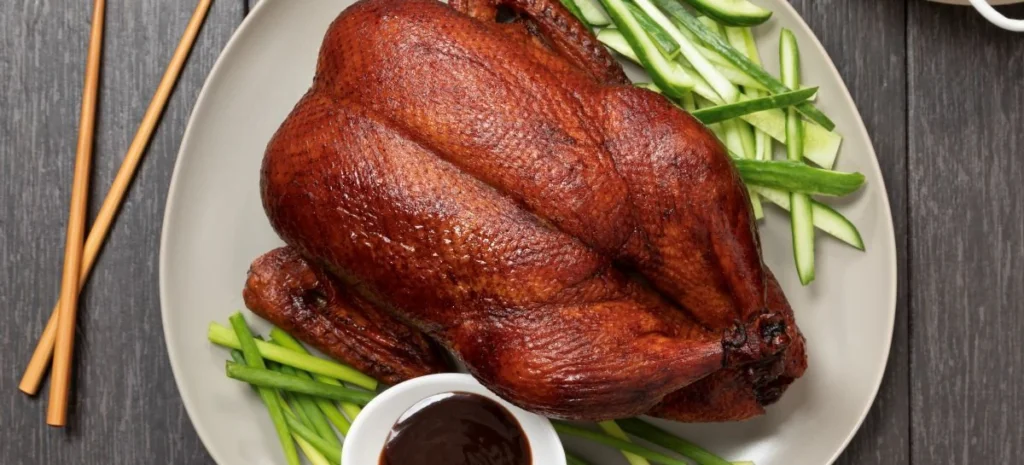

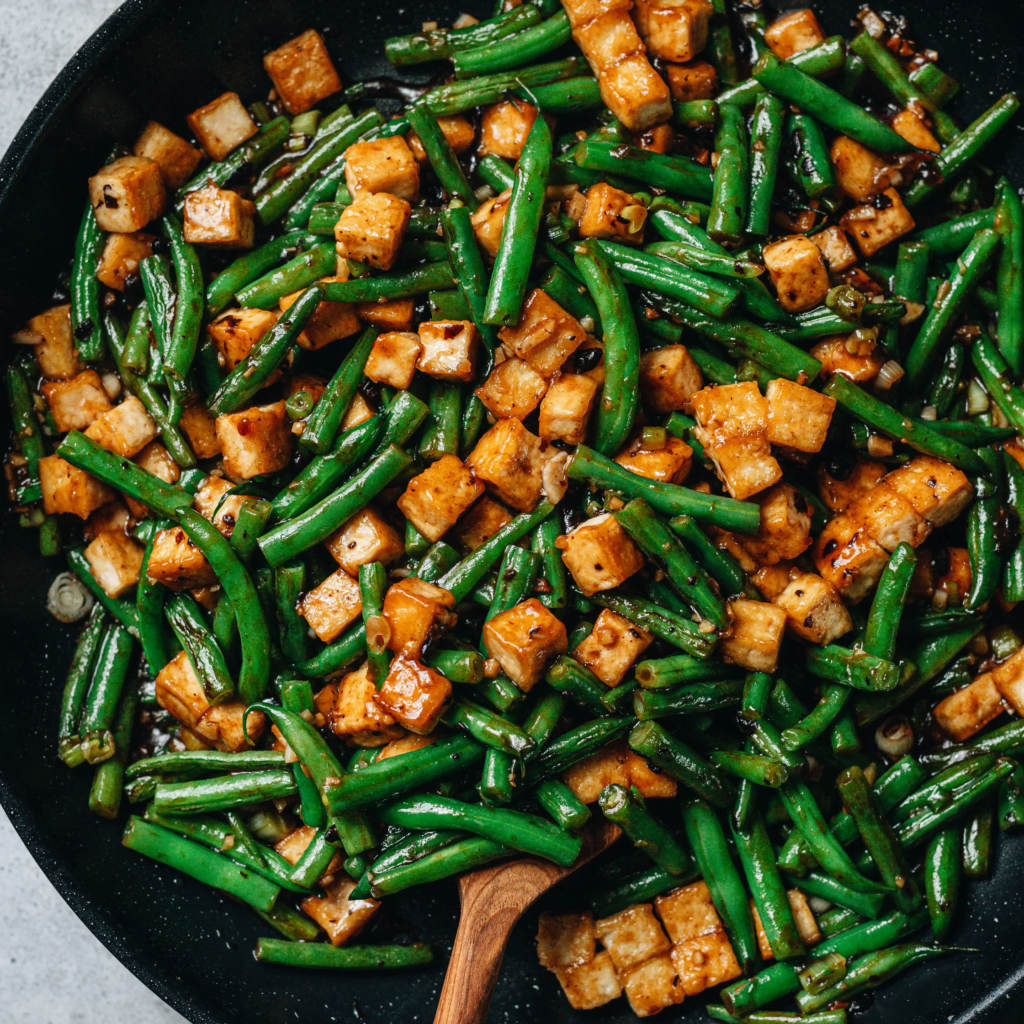


- 24 Chinese Beef Recipes: Culinary Marvels Unveiled in 24 Dishes!
- 39 Delicious Chinese Pork Recipes: Magic Unleashed in 39 Amazing Dishes!
- Explore 41 additional Irresistibly Delicious Chinese Dessert Recipes That Will Leave You Craving More!
- 48 Mouthwatering Chinese Vegan Food Recipes

